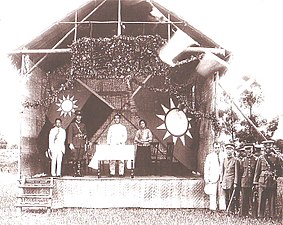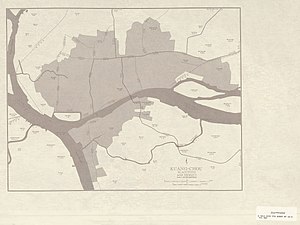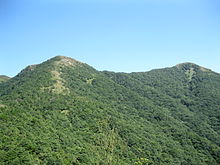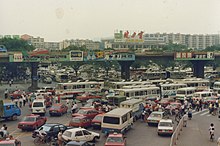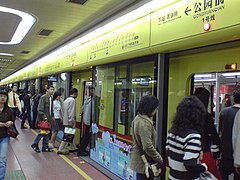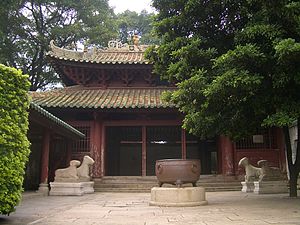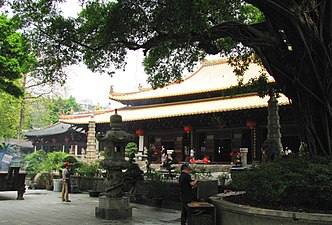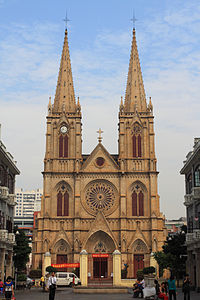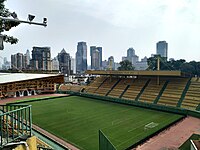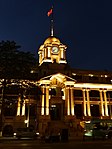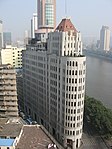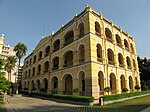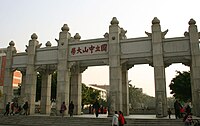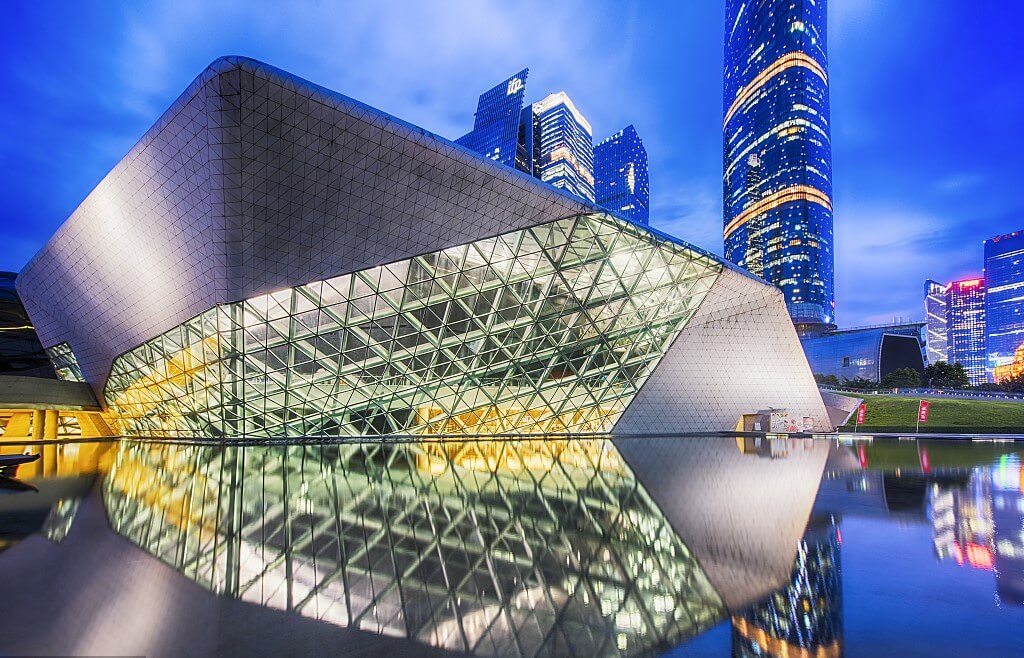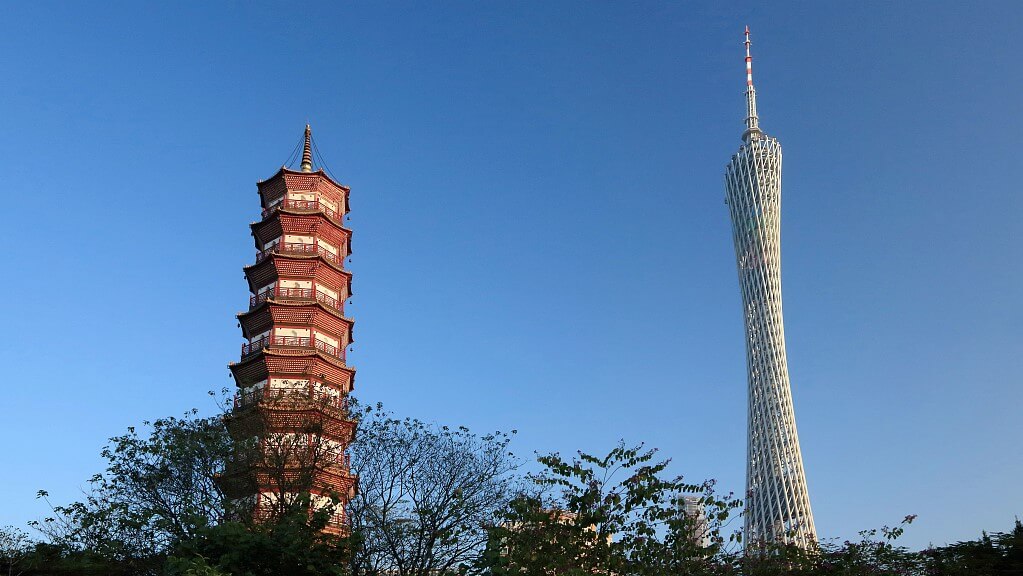For other places with same name «Canton», see Canton.
|
Guangzhou 广州市 Canton; Kwangchow |
|
|---|---|
|
Prefecture-level and subprovincial city |
|
|
Clockwise from top: Aerial view of Zhujiang New Town, Canton Tower and the Pearl River; Sacred Heart Cathedral; Sun Yat-sen Memorial Hall; Zhenhai Tower in Yuexiu Hill; Flowery Pagoda at the Temple of the Six Banyan Trees; and Five-Ram Sculpture |
|
| Nicknames:
City of Rams, City of Flowers, City of Rice Spike |
|
 |
|

Location of Guangzhou City jurisdiction in Guangdong |
|
|
Guangzhou Location of the city center in Guangdong Guangzhou Guangzhou (China) |
|
| Coordinates (Guangdong People’s Government): 23°07′48″N 113°15′36″E / 23.13000°N 113.26000°ECoordinates: 23°07′48″N 113°15′36″E / 23.13000°N 113.26000°E | |
| Country | China |
| Province | Guangdong |
| Settled | 214 BC |
| Founded by | Qin dynasty |
| Municipal seat | Yuexiu District |
| Government | |
| • Type | Sub-provincial city |
| • Body | Guangzhou Municipal People’s Congress |
| • CCP Secretary | Lin Keqing |
| • Congress Chairman | Wang Yanshi |
| • Mayor | Guo Yonghang |
| • CPPCC Chairman | Li Yiwei |
| Area
[1] |
|
| • Prefecture-level and subprovincial city | 7,434.4 km2 (2,870.4 sq mi) |
| • Urban | 3,843.431 km2 (1,483.957 sq mi) |
| • Metro | 19,870.4 km2 (7,672.0 sq mi) |
| Elevation | 21 m (69 ft) |
| Population
(2020 census)[2] |
|
| • Prefecture-level and subprovincial city | 18,676,605 |
| • Density | 2,500/km2 (6,500/sq mi) |
| • Urban
[3] |
16,492,590 |
| • Urban density | 4,300/km2 (11,000/sq mi) |
| • Metro | 65,594,622 |
| • Metro density | 3,300/km2 (8,500/sq mi) |
| Demonym | Cantonese |
| Time zone | UTC+08:00 (china standard time) |
| Postal code |
510000 |
| Area code | (0)20 |
| ISO 3166 code | CN-GD-01 |
| GDP (nominal)[4] | 2021 |
| — Total | ¥2.823 trillion $437.7 billion |
| — Per capita | ¥151,162 $23,436 |
| — Growth | |
| License plate prefixes | 粤A |
| City Flower | Bombax ceiba |
| City Bird | Chinese hwamei |
| Languages | Cantonese, Standard Chinese |
| Website | Guangzhou International |
| Guangzhou | ||||||||||||||||||||||||||||||
|---|---|---|---|---|---|---|---|---|---|---|---|---|---|---|---|---|---|---|---|---|---|---|---|---|---|---|---|---|---|---|

«Guangzhou» in Simplified (top) and Traditional (bottom) Chinese characters |
||||||||||||||||||||||||||||||
| Traditional Chinese | 廣州 | |||||||||||||||||||||||||||||
| Simplified Chinese | 广州 | |||||||||||||||||||||||||||||
| Postal | Canton Kwangchow |
|||||||||||||||||||||||||||||
| Literal meaning | «Broad Prefecture» | |||||||||||||||||||||||||||||
|
||||||||||||||||||||||||||||||
| abbreviation | ||||||||||||||||||||||||||||||
| Chinese | 穗 | |||||||||||||||||||||||||||||
|
Guangzhou (,[5] ;[6] simplified Chinese: 广州; traditional Chinese: 廣州; pinyin: Guǎngzhōu; Cantonese pronunciation: [kʷɔ̌ːŋ.tsɐ̂u] or [kʷɔ̌ːŋ.tsɐ́u] (listen), also known as Canton[7] () and alternatively romanized as Kwongchow or Kwangchow,[8] is the capital and largest city of Guangdong province in southern China.[9] Located on the Pearl River about 120 km (75 mi) north-northwest of Hong Kong and 145 km (90 mi) north of Macau, Guangzhou has a history of over 2,200 years and was a major terminus of the maritime Silk Road;[10] it continues to serve as a major port and transportation hub as well as being one of China’s three largest cities.[11] For a long time, the only Chinese port accessible to most foreign traders, Guangzhou was captured by the British during the First Opium War. No longer enjoying a monopoly after the war, it lost trade to other ports such as Hong Kong and Shanghai, but continued to serve as a major transshipment port. Due to a high urban population and large volumes of port traffic, Guangzhou is classified as a Large-Port Megacity, the largest type of port-city in the world.[12] Due to worldwide travel restrictions at the beginning of the COVID-19 pandemic, Guangzhou Baiyun International Airport, the major airport of Guangzhou, briefly became the world’s busiest airport by passenger traffic in 2020.[13]
Guangzhou is at the heart of the Guangdong–Hong Kong–Macau Greater Bay Area, the most-populous built-up metropolitan area in the world, which extends into the neighboring cities of Foshan, Dongguan, Zhongshan, Shenzhen and part of Jiangmen, Huizhou, Zhuhai and Macau, forming the largest urban agglomeration on Earth with approximately 65,594,622 residents[14] and part of the Pearl River Delta Economic Zone. Administratively, the city holds subprovincial status[15] and is one of China’s nine National Central Cities.[16] In the late 1990s and early 2000s, nationals of sub-Saharan Africa who had initially settled in the Middle East and Southeast Asia moved in unprecedented numbers to Guangzhou in response to the 1997/98 Asian financial crisis.[17] The domestic migrant population from other provinces of China in Guangzhou was 40% of the city’s total population in 2008. Guangzhou has one of the most expensive real estate markets in China.[18] As of the 2020 census, the registered population of the city’s expansive administrative area was 18,676,605 individuals (up to 47% from the previous census in 2010) whom 16,492,590 lived in 9 urban districts (all but Conghua and Zengcheng).[2] Guangzhou is the fifth most populous city by urban resident population in China after Shanghai, Beijing, Shenzhen and Chongqing.[19]
In modern commerce, Guangzhou is best known for its annual Canton Fair, the oldest and largest trade fair in China.[20] For three consecutive years (2013–2015), Forbes ranked Guangzhou as the best commercial city in mainland China.[21] Guangzhou is highly ranked as an Alpha- (global first-tier) city together with San Francisco and Stockholm.[22] It is a leading financial centre in the Asia-Pacific region and ranks 21st globally in the 2020 Global Financial Centres Index.[23] As an important international city, Guangzhou has hosted numerous international and national sporting events, the most notable being the 2010 Asian Games, the 2010 Asian Para Games, and the 2019 FIBA Basketball World Cup. The city hosts 65 foreign representatives, making it the third major city to host more foreign representatives than any other city in China after Beijing and Shanghai.[24][25] As of 2020, Guangzhou ranks 10th in the world and 5th in China (after Beijing, Shanghai, Hong Kong and Shenzhen) for the number of billionaire residents by the Hurun Global Rich List.[26]
Guangzhou is a major centre of research and innovation in the Asia-Pacific with a high level of scientific research output, ranking 10th globally, 5th in the Asia-Pacific and 4th in China,[27] and is home to many of China’s most prestigious universities, including Sun Yat-sen University, South China University of Technology, Jinan University, South China Normal University, South China Agricultural University, Guangzhou University, Southern Medical University, Guangdong University of Technology, Guangzhou Medical University, Guangzhou University of Chinese Medicine.[28][29][30]
Toponymy[edit]
Guǎngzhōu is the official romanization of the Chinese name 广州. The name of the city is taken from the ancient «Guang Province» after it had become the prefecture’s seat of government. The character 廣 or 广 means «broad» or «expansive».
Before acquiring its current name, the town was known as Panyu (Punyü; 番禺), a name still borne by one of Guangzhou’s districts not far from the main city. The origin of the name is still uncertain, with 11 various explanations being offered,[31] including that it may have referred to two local mountains.[32][33] The city has also sometimes been known as Guangzhou Fu or Guangfu after its status as the capital of a prefecture. From this latter name, Guangzhou was known to medieval Persians such as Al-Masudi and Ibn Khordadbeh[34] as Khanfu (خانفو).[35] Under the Southern Han, the city was renamed Xingwang Fu (興王府).[36][37]
The Chinese abbreviation for Guangzhou is «穗,» pronounced Seoi6 in Cantonese and Suì in Mandarin (although the abbreviation on car license plates, as with the rest of the province, is 粤), after its nickname «City of Rice» (穗城). The city has long borne the nickname City of Rams (羊城) or City of the Five Rams (五羊城) from the five stones at the old Temple of the Five Immortals said to have been the sheep or goats ridden by the Taoist culture heroes credited with introducing rice cultivation to the area around the time of the city’s foundation.[38] The former name «City of the Immortals» (仙城/五仙城) came from the same story. The more recent City of Flowers (花城) is usually taken as a simple reference to the area’s fine greenery.
The English name «Canton» derived from Portuguese Cantão[39] or Cidade de Cantão,[40] a blend of dialectical pronunciations of «Guangdong»[41][42] (e.g., Cantonese Gwong2-dung1). Although it originally and chiefly applied to the walled city, it was occasionally conflated with Guangdong by some authors.[note 1][note 2] It was adopted as the Postal Map Romanization of Guangzhou, and remained the official name until its name change to «Guangzhou.» As an adjective, it is still used in describing the people, language, cuisine and culture of Guangzhou and the surrounding Liangguang region. The 19th-century name was referred «Kwang-chow foo«[44]
History[edit]
Prehistory[edit]
A settlement now known as Nanwucheng was present in the area by 1100 BC.[45][46] Some traditional Chinese histories placed Nanwucheng’s founding during the reign of Ji Yan,[47][48] king of Zhou from 314 to 256 BC. It was said to have consisted of little more than a stockade of bamboo and mud.[47][48]
Nanyue[edit]
Guangzhou, then known as Panyu, was founded on the eastern bank of the Pearl River[44] in 214 BC. It was the seat of Qin Empire’s Nanhai Commandery, and served as a base for the first invasion of the Baiyue lands in southern China. Legendary accounts claimed that the soldiers at Panyu were so vigilant that they did not remove their armor for three years.[49] Upon the fall of the Qin, General Zhao Tuo established the kingdom of Nanyue and made Panyu its capital in 204 BC. It remained independent throughout the Chu-Han Contention, although Zhao negotiated recognition of his independence in exchange for his nominal submission to the Han in 196 BC.[50] Archeological evidence shows that Panyu was an expansive commercial center: in addition to items from central China, archeologists have found remains originating from Southeast Asia, India, and even Africa.[51] Zhao Tuo was succeeded by Zhao Mo and then Zhao Yingqi. Upon Zhao Yingqi’s death in 115 BC, his younger son Zhao Xing was named as his successor in violation of Chinese primogeniture. By 113 BC, his chinese mother, the Empress Dowager Jiu (樛) had prevailed upon him to submit Nanyue as a formal part of the Han Empire. The native prime minister Lü Jia (呂嘉) launched a coup, killing Han ambassadors along with the king, his mother, and their supporters.[52] A successful ambush then annihilated a Han force which had been sent to arrest him. Emperor Wu took offense and launched a massive river- and seaborne war: six armies under Lu Bode and Yang Pu[53] took Panyu and annexed Nanyue by the end of 111 BC.[52]
Imperial China[edit]
Old photograph of a commercial Guangzhou street c. 1880
Incorporated into the Han dynasty, Panyu became a provincial capital. In AD 226, it became the seat of Guang Prefecture, which gave it its modern name. The Old Book of Tang described Guangzhou as an important port in southern China.[54] Direct routes connected the Middle East and China, as shown in the records of a Chinese prisoner returning home from Iraq twelve years after his capture at Talas.[55] Relations were often strained: Arab and Persian pirates[56] sacked the city on October 30, 758[note 3][57][58][59][60] and about 200,000 foreigners were killed under the revenge of Chinese rebel Huang Chao in 878, along with the city’s Jews, Christians,[61][62][63] and Parsis.[64][65] The port was closed for fifty years after its destruction.[56]
Amid the Five Dynasties and Ten Kingdoms that followed the collapse of the Tang dynasty, the Later Liang governor Liu Yan used his base at Panyu to establish a «Great Yue» or «Southern Han» empire, which lasted from 917 to 971. The region enjoyed considerable cultural and economic success in this period. From the 10th to 12th century, there are records that the large foreign communities were not exclusively male, but included «Persian women».[66][67][note 4] According to Odoric of Pordenone, Guangzhou was as large as three Venices in terms of area, and rivaled all of Italy in the amount of crafts produced. He also noted the large amount of ginger available as well as large geese and snakes.[69] Guangzhou was visited by the Moroccan traveler Ibn Battuta during his 14th-century journey around the world;[70] he detailed the process by which the Chinese constructed their large ships in the port’s shipyards.[71]
Shortly after the Hongwu Emperor’s declaration of the Ming dynasty, he reversed his earlier support of foreign trade and imposed the first of a series of sea bans (海禁).[72] These banned private foreign trade upon penalty of death for the merchant and exile for his family and neighbors.[73] Previous maritime intendancies of Guangzhou, Quanzhou, and Ningbo were closed in 1384[74] and legal trade became limited to the tribute delegations sent to or by official representatives of foreign governments.[75]
Following the Portuguese conquest of the Melaka Sultanate, Rafael Perestrello traveled to Guangzhou as a passenger on a native junk in 1516.[76] His report induced Fernão Pires de Andrade to sail to the city with eight ships the next year,[76] but De Andrade’s exploration[77] was understood as spying[78] and his brother Simão and others began attempting to monopolize trade,[79] enslaving Chinese women[80] and children,[note 5] engaging in piracy,[82] and fortifying the island of Tamão.[83][84] Rumors even circulated that Portuguese were eating the children.[85][81][note 6] The Guangzhou administration was charged with driving them off:[82] they bested the Portuguese at the Battle of Tunmen[87] and in Xicao Bay; held a diplomatic mission hostage in a failed attempt to pressure the restoration of the sultan of Malacca,[88] who had been accounted a Ming vassal;[89] and, after placing them in cangues and keeping them for most of a year, ultimately executed 23 by lingchi.[90][note 7] With the help of local pirates,[85] the «Folangji» then carried out smuggling at Macao, Lampacau, and St John’s Island (now Shangchuan),[80] until Leonel de Sousa legalized their trade with bribes to Admiral Wang Bo (汪柏) and the 1554 Luso-Chinese Accord. The Portuguese undertook not to raise fortifications and to pay customs dues;[93] three years later, after providing the Chinese with assistance suppressing their former pirate allies,[94] the Portuguese were permitted to warehouse their goods at Macau instead of Guangzhou itself.[95]
In October 1646, the Longwu Emperor’s brother, Zhu Yuyue fled by sea to Guangzhou, the last stronghold of the Ming empire. On December 11, he declared himself the Shaowu Emperor, borrowing his imperial regalia from local theater troupes.[96] He led a successful offense against his cousin Zhu Youlang but was deposed and executed on 20 January 1647 when the Ming turncoat Li Chengdong (李成棟) sacked the city on behalf of the Qing.[97][note 8]
The Qing became somewhat more receptive to foreign trade after gaining control of Taiwan in 1683.[98] The Portuguese from Macau and Spaniards from Manila returned, as did private Muslim, Armenian, and English traders.[99] From 1699 to 1714, the French and British East India Companies sent a ship or two each year;[99] the Austrian Ostend General India Co. arrived in 1717,[100] the Dutch East India Co. in 1729,[101] the Danish Asiatic Co. in 1731,[note 9] and the Swedish East India Co. the next year.[99] These were joined by the occasional Prussian or Trieste Company vessel. The first independent American ship arrived in 1784, and the first colonial Australian one in 1788.[citation needed] By that time, Guangzhou was one of the world’s great ports, organized under the Canton System.[103] The main exports were tea and porcelain.[99] As a meeting place of merchants from all over the world, Guangzhou became a major contributor to the rise of the modern global economy.[104]
In the 19th century, most of the city’s buildings were still only one or two stories. However, there were notable exceptions such as the Flower Pagoda of the Temple of the Six Banyan Trees, and the guard tower known as the Five-Story Pagoda. The subsequently urbanized northern hills were bare and covered with traditional graves. The brick city walls were about 6 mi (10 km) in circumference, 25 ft (8 m) high, and 20 ft (6 m) wide. Its eight main gates and two water gates all held guards during the day and were closed at night. The wall rose to incorporate a hill on its northern side and was surrounded on the other three by a moat which, along with the canals, functioned as the city’s sewer, emptied daily by the river’s tides. A partition wall with four gates divided the northern «old town» from the southern «new town» closer to the river; the suburb of Xiguan (Saikwan; «West Gate») stretched beyond and the boats of fishers, traders, and Tanka («boat people») almost entirely concealed the riverbank for about 4 mi (6 km). It was common for homes to have a storefront facing the street and to treat their courtyards as a kind of warehouse.[44] The city was part of a network of signal towers so effective that messages could be relayed to Beijing—about 1,200 mi (1,931 km) away—in less than 24 hours.[105]
The Canton System was maintained until the outbreak of the First Opium War in 1839. Following a series of battles in the Pearl River Delta, the British captured Canton on March 18, 1841.[106] The Second Battle of Canton was fought two months later.[107] Following the Qing’s 1842 treaty with Great Britain, Guangzhou lost its privileged trade status as more and more treaty ports were opened to more and more countries, usually including extraterritorial enclaves. Amid the decline of Qing prestige and the chaos of the Red Turban Rebellion (1854–1856), the Punti and Hakka waged a series of clan wars from 1855 to 1867 in which one million people died. The foreign trade facilities were destroyed by local Chinese in the Arrow War (1856–1858). The international community relocated to the outskirts and most international trade moved through Shanghai.[108][109]
The concession for the Guangdong–Hankou Railway was awarded to the American China Development Co. in 1898. It completed its branch line west to Foshan and Sanshui before being engulfed in a diplomatic crisis after a Belgian consortium bought a controlling interest and the Qing subsequently canceled its concession. J.P. Morgan was awarded millions in damages[110] and the line to Wuchang was not completed until 1936[111] and the completion of a unified Beijing–Guangzhou Railway waited until the completion of Wuhan’s Yangtze River Bridge in 1957.
Modern China[edit]
Revolutions[edit]
During the late Qing dynasty, Guangzhou was the site of revolutionary attempts such as the Uprisings of 1895 and 1911 that were the predecessors of the successful Xinhai Revolution, which overthrew the Qing dynasty. The 72 revolutionaries whose bodies were found after the latter uprising are honored as the city’s 72 Martyrs at the Huanghuagang («Yellow Flower Mound») Mausoleum.
Republic of China[edit]
After the assassination of Sung Chiao-jen and Yuan Shih-kʻai’s attempts to remove the Nationalist Party of China from power, the leader of Guangdong Hu Hanmin joined the 1913 Second Revolution against him[112] but was forced to flee to Japan with Sun Yat-sen after its failure. The city came under national spotlight again in 1917, when Prime Minister Duan Qirui’s abrogation of the constitution triggered the Constitutional Protection Movement. Sun Yat-sen came to head the Guangzhou Military Government supported by the members of the dissolved parliament and the Southwestern warlords. The Guangzhou government fell apart as the warlords withdrew their support. Sun fled to Shanghai in November 1918 until the Guangdong warlord Chen Jiongming restored him in October 1920 during the Yuegui Wars.[113] On 16 June 1922, Sun was ousted in a coup and fled on the warship Yongfeng after Chen sided with the Zhili Clique’s Beijing government. In the following months Sun mounted a counterattack into Guangdong by rallying supporters from Yunnan and Guangxi, and in January established a government in the city for the third time.
From 1923 to 1926 Sun and the Kuomintang used the city as a base to prosecute a renewed revolution in China by conquering the warlords in the north. Although Sun was previously dependent on opportunistic warlords who hosted him in the city, with the leadership of Chiang Kai-shek, the KMT developed its own military power to serve its ambition. The Canton years saw the evolution of the KMT into a revolutionary movement with a strong military focus and ideological commitment, setting the tone of the KMT rule of China beyond 1927.
In 1924, the KMT made the momentous decision to ally with the Communist Party and the USSR. With Soviet help, KMT reorganized itself along the Leninist line and adopted a pro-labor and pro-peasant stance. The Kuomintang-CCP cooperation was confirmed in the First Congress of the KMT and the communists were instructed to join the KMT. The allied government set up the Peasant Movement Training Institute in the city, of which Mao Zedong was a director for one term. Sun and his military commander Chiang used Soviet funds and weapons to build an armed force staffed by communist commissars, training its cadres in the Whampoa Military Academy.[113] In August, the fledgling army suppressed the Canton Merchants’ Corps Uprising. The next year the anti-imperialist May Thirtieth Movement swept the country, and the KMT government called for strikes in Canton and Hong Kong. The tensions of the massive strikes and protests led to the Shakee Massacre.
After the death of Sun Yat-sen in 1925 the mood was changing in the party toward the communists. In August the left-wing KMT leader Liao Zhongkai was assassinated and the right-wing leader Hu Hanmin, the suspected mastermind, was exiled to the Soviet Union, leaving the pro-communist Wang Jingwei in charge. Opposing communist encroachment, the right-wing Western Hills Group vowed to expel the communists from the KMT. The «Canton Coup» on 20 March 1926 saw Chiang solidify his control over the Nationalists and their army against Wang Jingwei, the party’s left wing, its Communist allies, and its Soviet advisors.[114][115] By May, he had ended civilian control of the military[115] and begun his Northern Expedition against the warlords of the north. Its success led to the split of the KMT between Wuhan and Nanking and the purge of the communists in the April 12 Incident. Immediately afterwards Canton joined the purge under the auspice of Li Jishen, resulting in the arrest of communists and the suspension of left wing KMT apparatuses and labor groups. Later in 1927 when Zhang Fakui, a general supportive of the Wuhan faction seized Canton and installed Wang Jingwei’s faction in the city, the communists saw an opening and launched the Guangzhou Uprising. Prominent communist military leaders Ye Ting and Ye Jianying led the failed defense of the city. Soon, control of the city reverted to Li Jishen.
Li was deposed during a war between Chiang and the Kwangsi Clique. By 1929, Chen Jitang had established himself as the powerholder of Guangdong. In 1931 he threw his weight behind the anti-Chiang schism by hosting a separate Nationalist government in Guangzhou.[116] Opposing Chiang’s alleged dictatorship, the separatists included KMT leaders like Wang Ching-wei, Sun Fo and others from diverse factions. The peace negotiations amid the armed standoff led to the 4th National Congress of Kuomintang being held separately by three factions in Nanjing, Shanghai and Canton. Resigning all his posts, Chiang pulled off a political compromise that reunited all factions. While the intraparty division was resolved, Chen kept his power until he was defeated by Chiang in 1936. During the WW2, the «Canton Operation» subjected the city to Japanese occupation by the end of December 1938.
People’s Republic of China[edit]
Amid the closing months before total Communist victory, Guangzhou briefly served as the capital of the Republican government. Guangzhou was captured on 14 October 1949. Amid a massive exodus to Hong Kong and Macau, defeated Nationalist forces blew up the Haizhu Bridge across the Pearl River in retreat. The Cultural Revolution had a large effect on the city, with much of its temples, churches and other monuments destroyed during this chaotic period.
The People’s Republic of China initiated building projects including new housing on the banks of the Pearl River to adjust the city’s boat people to life on land. Since the 1980s, the city’s close proximity to Hong Kong and Shenzhen and its ties to overseas Chinese made it one of the first beneficiaries of China’s opening up under Deng Xiaoping. Beneficial tax reforms in the 1990s also helped the city’s industrialization and economic development.
The municipality was expanded in the year 2000, with Huadu and Panyu joining the city as urban districts and Conghua and Zengcheng as more rural counties. The former districts of Dongshan and Fangcun were abolished in 2005, merged into Yuexiu and Liwan respectively. The city acquired Nansha and Luogang. The former was carved out of Panyu, the latter from parts of Baiyun, Tianhe, Zengcheng, and an exclave within Huangpu. The National People’s Congress approved a development plan for the Pearl River Delta in January 2009; on March 19 the same year, the Guangzhou and Foshan municipal governments agreed to establish a framework to merge the two cities.[117] In 2014, Luogang merged into Huangpu and both Conghua and Zengcheng counties were upgraded to districts.
On June 16, 2022, an EF2 tornado struck the city, causing major power outages and knocking out power to the city’s subway lines.[118][119][120]
Gallery[edit]
-
Nieuhof’s imaginative 1665 map of «Kanton»,[121] made from secondhand accounts when Europeans were still forbidden from entering the walled city
-
An 1855 painting of the gallery of Tingqua, one of the most successful suppliers of «export paintings» for Guangzhou’s foreign traders.
Common themes included the Thirteen Factories, the Whampoa Anchorage (now Pazhou), and the Sea-Banner Temple (now Hoi Tong Monastery). -
Vrooman’s 1860 map of the «City and Entire Suburbs of Canton», one of the first made after the treaties of Tianjin and Beijing permitted foreigners full access to Guangzhou’s walled city
-
-
-
Street scene in Guangzhou, 1919
-
The US Navy’s Dept of Navigation’s 1920 map of «Canton»[122]
-
-
The Guangzhou Bund in 1930, with rows of Tanka boats
-
A short film of Guangzhou in 1937
-
Map of Guangzhou (labeled as KUANG-CHOU (CANTON))
Geography[edit]
Map of Guangzhou (labeled as KUANG-CHOU (CANTON) 廣州) in surrounding region (AMS, 1954)
The old town of Guangzhou was near Baiyun Mountain on the east bank of the Pearl River (Zhujiang) about 80 mi (129 km) from its junction with the South China Sea and about 300 mi (483 km) below its head of navigation.[44] It commanded the rich alluvial plain of the Pearl River Delta, with its connection to the sea protected at the Humen Strait.[44] The present city spans 7,434.4 km2 (2,870.4 sq mi) on both sides of the river from 112° 57′ to 114° 03′ E longitude and 22° 26′ to 23° 56′ N latitude in south-central Guangdong. The Pearl is the 4th-largest river of China.[123] Intertidal ecosystems exist on the tidal flat lining the river estuary, however, many of the tidal flats have been reclaimed for agriculture.[124] Baiyun Mountain is now locally referred to as the city’s «lung» (市肺).[11][125][why?]
The elevation of the prefecture generally increases from southwest to northeast, with mountains forming the backbone of the city and the ocean comprising the front. Tiantang Peak (simplified Chinese: 天堂顶; traditional Chinese: 天堂頂, «Heavenly Peak») is the highest point of elevation at 1,210 m (3,970 ft) above sea level.
Natural resources[edit]
There are 47 different types of minerals and also 820 ore fields in Guangzhou, including 18 large and medium-sized oil deposits. The major minerals are granite, cement limestone, ceramic clay, potassium, albite, salt mine, mirabilite, nepheline, syenite, fluorite, marble, mineral water, and geothermal mineral water. Since Guangzhou is located in the water-rich area of southern China, it has a wide water area with many rivers and water systems, accounting for 10% of the total land area. The rivers and streams improve the landscape and keep the ecological environment of the city stable.[126]
Climate[edit]
Despite being located just south of the Tropic of Cancer, Guangzhou has a humid subtropical climate (Köppen Cwa) influenced by the East Asian monsoon. Summers are wet with high temperatures, high humidity, and a high heat index. Winters are mild and comparatively dry. Guangzhou has a lengthy monsoon season, spanning from April through September. Monthly averages range from 13.8 °C (56.8 °F) in January to 28.9 °C (84.0 °F) in July, while the annual mean is 22.4 °C (72.3 °F).[11] Autumn, from October to December, is very moderate, cool and windy, and is the best travel time.[127] The relative humidity is approximately 76 percent, whereas annual rainfall in the metropolitan area is over 1,950 mm (77 in).[11] With monthly percent possible sunshine ranging from 17 percent in March to 51 percent in October, the city receives 1,559 hours of bright sunshine annually, considerably less than nearby Shenzhen and Hong Kong. Extreme temperatures have ranged from 0 °C (32 °F) to 39.1 °C (102.4 °F).[128] The last recorded snowfall in the city was on 24 January 2016, 87 years after the second last recorded snowfall.[129]
| Climate data for Guangzhou (normals 1991–2020, extremes 1951–2010) | |||||||||||||
|---|---|---|---|---|---|---|---|---|---|---|---|---|---|
| Month | Jan | Feb | Mar | Apr | May | Jun | Jul | Aug | Sep | Oct | Nov | Dec | Year |
| Record high °C (°F) | 28.4 (83.1) |
29.4 (84.9) |
32.1 (89.8) |
33.3 (91.9) |
36.2 (97.2) |
38.9 (102.0) |
39.1 (102.4) |
38.3 (100.9) |
37.6 (99.7) |
36.2 (97.2) |
33.4 (92.1) |
29.6 (85.3) |
39.1 (102.4) |
| Average high °C (°F) | 18.7 (65.7) |
20.0 (68.0) |
22.3 (72.1) |
26.4 (79.5) |
30.0 (86.0) |
32.0 (89.6) |
33.3 (91.9) |
33.2 (91.8) |
32.0 (89.6) |
29.3 (84.7) |
25.3 (77.5) |
20.7 (69.3) |
26.9 (80.5) |
| Daily mean °C (°F) | 13.8 (56.8) |
15.5 (59.9) |
18.3 (64.9) |
22.5 (72.5) |
26.0 (78.8) |
27.9 (82.2) |
28.9 (84.0) |
28.6 (83.5) |
27.4 (81.3) |
24.4 (75.9) |
20.2 (68.4) |
15.4 (59.7) |
22.4 (72.3) |
| Average low °C (°F) | 10.6 (51.1) |
12.5 (54.5) |
15.5 (59.9) |
19.6 (67.3) |
23.1 (73.6) |
25.1 (77.2) |
25.8 (78.4) |
25.5 (77.9) |
24.2 (75.6) |
20.9 (69.6) |
16.7 (62.1) |
11.9 (53.4) |
19.3 (66.7) |
| Record low °C (°F) | 0.1 (32.2) |
1.3 (34.3) |
3.2 (37.8) |
7.7 (45.9) |
14.6 (58.3) |
18.8 (65.8) |
21.6 (70.9) |
20.9 (69.6) |
15.5 (59.9) |
9.5 (49.1) |
4.9 (40.8) |
0.0 (32.0) |
0.0 (32.0) |
| Average precipitation mm (inches) | 51.1 (2.01) |
56.1 (2.21) |
101.0 (3.98) |
193.8 (7.63) |
329.0 (12.95) |
364.9 (14.37) |
242.6 (9.55) |
270.3 (10.64) |
203.2 (8.00) |
67.3 (2.65) |
37.4 (1.47) |
33.4 (1.31) |
1,950.1 (76.77) |
| Average precipitation days (≥ 0.1 mm) | 7.2 | 9.4 | 13.8 | 15.3 | 17.4 | 19.4 | 17.0 | 16.8 | 12.0 | 5.7 | 5.7 | 5.7 | 145.4 |
| Average relative humidity (%) | 72 | 76 | 80 | 82 | 81 | 82 | 79 | 80 | 77 | 70 | 69 | 67 | 76 |
| Mean monthly sunshine hours | 112.9 | 77.5 | 61.6 | 69.1 | 103.4 | 127.5 | 179.0 | 166.4 | 167.0 | 182.2 | 159.7 | 152.7 | 1,559 |
| Percent possible sunshine | 33 | 24 | 17 | 18 | 25 | 32 | 43 | 42 | 46 | 51 | 49 | 46 | 36 |
| Source: China Meteorological Data Service Center [130][131][132] all-time extreme temperature[128] |
Administrative divisions[edit]
Guangzhou is a sub-provincial city. It has direct jurisdiction over eleven districts:
|
Liwan Yuexiu Haizhu Tianhe Baiyun Huangpu Panyu Huadu Nansha Conghua Zengcheng |
|
||||||||||||||||||||||||||||||||||||||||||||||||||||||||||||||||||||||||||||||||||||||||||||||||||||||||||||||||||||||||||||||||||||
|
Economy[edit]
Guangzhou is the main manufacturing hub of the Pearl River Delta, one of mainland China’s leading commercial and manufacturing regions. In 2021, its GDP reached ¥2,823 billion (US$444.37 billion in nominal), making it the 2nd largest economy in the South-Central China region after Shenzhen.[137] Guangzhou’s GDP (nominal) was US$444.37 billion in 2021, exceeding that of Nigeria with a GDP of US$ 440.77 billion, the largest economy in Africa.[138] Guangzhou’s per capita was ¥151,162 (US$23,794 in nominal).[137] Guangzhou is considered one of the most prosperous cities in China. Guangzhou ranks 10th in the world and 5th in China (after Beijing, Shanghai, Hong Kong and Shenzhen) in terms of the number of billionaires according to the Hurun Global Rich List 2020.[26] Guangzhou is projected to be among the world top 10 largest cities in terms of nominal GDP in 2035 (together with Shanghai, Beijing and Shenzhen in China) according to a study by Oxford Economics,[139] and its nominal GDP per capita will reach above US$42,000 in 2030.[140] Guangzhou also ranks 21st globally (between Washington, D.C. and Amsterdam) and 8th in the whole Asia & Oceania region (behind Shanghai, Tokyo, Hong Kong, Singapore, Beijing, Shenzhen and Dubai) in the 2020 Global Financial Centers Index (GFCI).[23] Owing to rapid industrialization, it was once also considered a rather polluted city. After green urban planning was implemented, it is now one of the most livable cities in China.
Canton Fair[edit]
The Canton Fair, formally the «China Import and Export Fair», is held every year in April and October by the Ministry of Trade. Inaugurated in the spring of 1957, the fair is a major event for the city. It is the trade fair with the longest history, highest level, and largest scale in China.[141] From the 104th session onwards, the fair moved to the new Guangzhou International Convention and Exhibition Center (广州国际会展中心) in Pazhou, from the older complex in Liuhua. The GICEC is served by two stations on Line 8 and three stations on Tram Line THZ1. Since the 104th session, the Canton Fair has been arranged in three phases instead of two phases.
-
Guangzhou skyline
-
The former Canton Fair site at Yuexiu’s Liuhua Complex
Local products[edit]
- Cantonese cuisine is one of China’s most famous and popular regional cuisines, with a saying stating simply to «Eat in Guangzhou» (食在廣州).[note 10]
- Cantonese sculpture includes work in jade, wood, and (controversially) ivory.
- Canton porcelain developed over the past three centuries as one of the major forms of exportware. It is now known within China for its highly colorful style.
- Cantonese embroidery is one of china’s four main styles of the embroidery.
- Zhujiang Beer, a pale lager, is one of China’s most successful brands.
Industry[edit]
- GAC Group
- Guangzhou Economic and Technological Development Zone
- Guangzhou Nansha Export Processing Zone
- The Export Processing Zone was founded in 2005. Its total planned area is 1.36 km2 (0.53 sq mi).[142] It is located in Nansha District and it belongs to the provincial capital, Guangzhou. The major industries encouraged in the zone include automobile assembly, biotechnology and heavy industry. It is situated 54 km (34 mi) (a 70 minutes drive) south of Guangzhou Baiyun International Airport and close to Nansha Port. It also has the advantage of Guangzhou Metro line 4 which is being extended to Nansha Ferry Terminal.
- Guangzhou Free Trade Zone
- The zone was founded in 1992. It is located in the east of Huangpu District and near to Guangzhou Economic and Technological Development Zone. It is also very close to Guangzhou Baiyun Airport.[143] The major industries encouraged in the zone include international trade, logistics, processing and computer software. Recently the Area has been rebranded and is now being marketed under the name Huangpu District. Next to the industries above, new sectors are being introduced to the business environment, including new energy, AI, new mobility, new materials, information and communication technology and new transport. It is also Home to the Guangzhou IP Court.[144]
- Guangzhou Science City
Business Environment[edit]
Guangzhou is a hub for international businesses. According to an article by China Briefing, over 30,000 foreign-invested companies had settled in Guangzhou by 2018, including 297 Fortune Global 500 companies with projects and 120 Fortune Global 500 companies with headquarters or regional headquarters in the city.[145]
Demographics[edit]
| Year | Pop. | ±% |
|---|---|---|
| 1950[146] | 2,567,645 | — |
| 1960[146] | 3,683,104 | +43.4% |
| 1970[146] | 4,185,363 | +13.6% |
| 1980[146] | 5,018,638 | +19.9% |
| 1990[146] | 5,942,534 | +18.4% |
| 2000[146] | 9,943,000 | +67.3% |
| 2002[147] | 10,106,229 | +1.6% |
| 2005[148] | 9,496,800 | −6.0% |
| 2006[148] | 9,966,600 | +4.9% |
| 2007[148] | 10,530,100 | +5.7% |
| 2008[148] | 11,153,400 | +5.9% |
| 2009[148] | 11,869,700 | +6.4% |
| 2010[146] | 12,701,948 | +7.0% |
| 2011[149] | 12,751,400 | +0.4% |
| 2012[149] | 12,832,900 | +0.6% |
| 2013[149] | 12,926,800 | +0.7% |
| 2014[149] | 13,080,500 | +1.2% |
| 2018 | 14,904,400 | +13.9% |
| Population size may be affected by changes to administrative divisions. |
The 2010 census found Guangzhou’s population to be 12.78 million. As of 2014, it was estimated at 13,080,500,[150][149] with 11,264,800 urban residents.[3] Its population density is thus around 1,800 people per km2. The built-up area of the Guangzhou proper connects directly to several other cities. The built-up area of the Pearl River Delta Economic Zone covers around 17,573 km2 (6,785 sq mi) and has been estimated to house 22 million people, including Guangzhou’s nine urban districts, Shenzhen (5.36m), Dongguan (3.22m), Zhongshan (3.12m), most of Foshan (2.2m), Jiangmen (1.82m), Zhuhai (890k), and Huizhou’s Huiyang District (760k).[citation needed] The total population of this agglomeration is over 28 million after including the population of the adjacent Hong Kong Special Administrative Region.[citation needed] The area’s fast-growing economy and high demand for labor has produced a huge «floating population» of migrant workers; thus, up to 10 million migrants reside in the area least six months each year.[citation needed] In 2008, about five million of Guangzhou’s permanent residents were hukouless migrants.[151]
Ethnicity and language[edit]
Most of Guangzhou’s population is Han Chinese. Almost all Cantonese people speak Cantonese as their first language,[153] while most migrants speak forms of Mandarin.[151] In 2010, each language was the native tongue of roughly half of the city’s population,[154] although minor but substantial numbers speak other varieties as well.[citation needed] In 2018, He Huifeng of the South China Morning Post stated that younger residents have increasingly favored using Mandarin instead of Cantonese in their daily lives, causing their Cantonese-speaking grandparents and parents to use Mandarin to communicate with them. He Huifeng stated that factors included local authorities discouraging the use of Cantonese in schools and the rise in prestige of Mandarin-speaking Shenzhen.[155] Jinan University released a survey result of the Guangzhou youths born in the year 2000 or after that were part of this educational study showed that 69% could still speak and understand Cantonese, 20% can understand Cantonese, but unable to speak it, and 11% completely had no knowledge of Cantonese. Jinan University’s study of these Guangzhou youths also indicated when it came to the daily recreational use of Cantonese, roughly 40%-50% of them participated in these recreational functions with the usage of Cantonese with 51.4% of them in mobile games, 47% in Social Platforms, 44.1% in TV shows, and 39.8% in Books and Newspapers. Despite some decline in the use of Cantonese, it is faring better in survival, popularity, and prestige than other Chinese languages due to the historical pride in the language and culture, as well as the wide popularity and availability of mainstream Cantonese entertainment, which encourages locals to retain the Cantonese language.[156][157] As of the 2020s, additional renewed efforts were introduced to preserve the local Cantonese language and culture with some limited Cantonese language classes now being taught in some schools as well as hosting Cantonese appreciation cultural events along with hosting activities that cater to the local Cantonese culture and language as well as many local Cantonese speaking families are now placing much stronger emphasis on their children to speak Cantonese to preserve the culture and language. In a 2018 report study by Shan Yunming and Li Sheng, the report showed that 90% of people living in Guangzhou are bilingual in both Cantonese and Mandarin, though fluency will vary depending on if they are locally born to the city and the surrounding Guangdong province or migrants from other provinces, which shows how much importance the Cantonese language still has in the city despite the strict policy rules from the government to be using Mandarin as the country’s official language.[158][159] Guangzhou has an even more unbalanced gender ratio than the rest of the country. While most areas of China have 112–120 boys per 100 girls, the Guangdong province that houses Guangzhou has more than 130 boys for every 100 girls.[160] [161][162]
Recent years have seen a huge influx of migrants, with up to 30 million additional migrants living in the Guangzhou area for at least six months out of every year with the majority being female migrants and many becoming local Guangzhou people. This huge influx of people from other areas, called the floating population, is due to the city’s fast-growing economy and high labor demands. Guangzhou Mayor Wan Qingliang told an urban planning seminar that Guangzhou is facing a very serious population problem stating that, while the city had 10.33 million registered residents at the time with targets and scales of land use based on this number, the city actually had a population with migrants of nearly 15 million. According to the Guangzhou Academy of Social Sciences researcher Peng Peng, the city is almost at its maximum capacity of just 15 million, which means the city is facing a great strain, mostly due to a high population of unregistered people.[160]
According to the 2000 National Census, marriage is one of the top two reasons for permanent migration and particular important for women as 29.3% of the permanent female migrants migrate for marriage [Liang et al.,2004]. Many of the female economic migrants marry men from Guangzhou in hopes of a better life.[163] but like elsewhere in the People’s Republic of China, the household registration system (hukou) limits migrants’ access to residences, educational institutions and other public benefits. It has been noted that many women end up in prostitution.[164] In May 2014, legally employed migrants in Guangzhou were permitted to receive a hukou card allowing them to marry and obtain permission for their pregnancies in the city, rather than having to return to their official hometowns as previously.[165]
Historically, the Cantonese people have made up a sizable part of the 19th- and 20th-century Chinese diaspora; in fact, many overseas Chinese have ties to Guangzhou. This is particularly true in the United States,[166] Canada,[167] and Australia.
Demographically, the only significant immigration into China has been by overseas Chinese, but Guangzhou sees many foreign tourists, workers, and residents from the usual locations such as the United States. Notably, it is also home to thousands of African immigrants, including people from Nigeria, Somalia, Angola and the Democratic Republic of Congo.[168]
Metropolitan area[edit]
The encompassing metropolitan area was estimated by the OECD (Organization for Economic Cooperation and Development) to have, as of 2010, a population of 25 million.[169][170]
Development of Guangzhou[edit]
ScienceDirect provided a report on their website of the development of Guangzhou from 1990 until 2020. Their map report showed in 1990, the developed residential districts were almost exclusively concentrated to a small part of western Guangzhou whereas other parts of Guangzhou had smaller limited amount of developed residential communities being overwhelmingly surrounded by agricultural and forest lands. However, from 2005 until 2020, other parts of the city eventually began to develop more so residential communities and in the 2020 map report, it showed fully developed residential communities going from west to east of the city whereas the very southern part and large portions of northern Guangzhou still remain mainly agricultural and forest lands with very limited developed residential communities.
[171][172][173]
Transportation[edit]
Urban mass transit[edit]
When the first line of the Guangzhou Metro opened in 1997, Guangzhou was the fourth city in Mainland China to have an underground railway system, behind Beijing, Tianjin, and Shanghai. Currently the metro network is made up of thirteen lines, covering a total length of 476.26 km (295.93 mi).[174] A long-term plan is to make the city’s metro system expand to over 500 km (310 mi) by 2020 with 15 lines in operation. In addition to the metro system there is also the Haizhu Tram line which opened on 31 December 2014.[175]
The Guangzhou Bus Rapid Transit (GBRT) system which was introduced in 2010 along Zhongshan Road. It has several connections to the metro and is the world’s 2nd-largest bus rapid transit system with 1,000,000 passenger trips daily.[176] It handles 26,900 pphpd during the peak hour a capacity second only to the TransMilenio BRT system in Bogota.[177] The system averages one bus every 10 seconds or 350 per hour in a single direction and contains the world’s longest BRT stations—around 260 m (850 ft) including bridges.
Motor transport[edit]
In the 19th century, the city already had over 600 long, straight streets; these were mostly paved but still very narrow.[44] In June 1919, work began on demolishing the city wall to make way for wider streets and the development of tramways. The demolition took three years in total.[178]
In 2009, it was reported that all 9,424 buses and 17,695 taxis in Guangzhou would be operating on LPG-fuel by 2010 to promote clean energy for transport and improve the environment ahead of the 2010 Asian Games which were held in the city.[179] At present[when?], Guangzhou is the city that uses the most LPG-fueled vehicles in the world, and at the end of 2006, 6,500 buses and 16,000 taxis were using LPG, taking up 85 percent of all buses and taxis.[citation needed]
Effective January 1, 2007, the municipal government banned motorcycles in Guangdong’s urban areas. Motorcycles found violating the ban are confiscated.[180] The Guangzhou traffic bureau claimed to have reported reduced traffic problems and accidents in the downtown area since the ban.[181]
Airports[edit]
Guangzhou’s main airport is the Baiyun International Airport in Baiyun District; it opened on August 5, 2004.[182] This airport is the second busiest airport in terms of traffic movements in China. It replaced the old Baiyun International Airport, which was very close to the city center but failed to meet the city’s rapidly growing air traffic demand. The old Baiyun International Airport was in operation for 72 years. Guangzhou Baiyun International Airport now has three runways, with two more planned.[183] Terminal 2 opened on April 26, 2018.[184] Another airport located in Zengcheng District is under planning.[185]
Guangzhou is served by Hong Kong International Airport; ticketed passengers can take ferries from the Lianhuashan Ferry Terminal and Nansha Ferry Port in Nansha District to the HKIA Skypier.[186] There are also coach bus services connecting Guangzhou with HKIA.[187]
Railways[edit]
Guangzhou is the terminus of the Beijing–Guangzhou, Guangzhou–Shenzhen, Guangzhou–Maoming and Guangzhou–Meizhou–Shantou conventional speed railways. In late 2009, the Wuhan–Guangzhou high-speed railway started service, with multiple unit trains covering 980 km (608.94 mi) at a top speed of 320 km/h (199 mph). In December 2014, the Guiyang–Guangzhou high-speed railway and Nanning-Guangzhou railway began service with trains running at top speeds of 250 km/h (155 mph) and 200 km/h (124 mph), respectively.[188] The Guangdong Through Train departs from the Guangzhou East railway station and arrives at the Hung Hom station in Kowloon, Hong Kong. The route is approximately 182 km (113 mi) in length and the ride takes less than two hours. Frequent coach services are also provided with coaches departing every day from different locations (mostly major hotels) around the city. A number of regional railways radiating from Guangzhou started operating such as the Guangzhou–Zhuhai intercity railway and the Guangzhou-Foshan-Zhaoqing intercity railway.
Water transport[edit]
There are daily high-speed catamaran services between Nansha Ferry Terminal and Lianhua Shan Ferry Terminal in Guangzhou and the Hong Kong China Ferry Terminal, as well as between Nansha Ferry Terminal and Macau Ferry Pier in Hong Kong.
Culture[edit]
Within China, the culture of the Cantonese people is a subset of the larger «Southern» or «Lingnan» cultural areas. Notable aspects of Guangzhou’s cultural heritage include:
- Cantonese language, the local and prestige variant of Yue Chinese.
- Cantonese cuisine, one of China’s eight major culinary traditions[189][note 11]
- Cantonese opera, usually divided into martial and literary performances
- Xiguan (Saikwan), the area west of the former walled city
The Guangzhou Opera House & Symphony Orchestra also perform classical Western music and Chinese compositions in their style. Cantonese music is a traditional style of Chinese instrumental music, while Cantopop is the local form of pop music and rock-and-roll which developed from neighboring Hong Kong.
Religions[edit]
Before the postmodern era, Guangzhou had about 124 religious pavilions, halls, and temples.[44] Today, in addition to the Buddhist Association, Guangzhou also has a Taoist Association, a Jewish community,[191][192] as well as a history with Christianity, reintroduced to China by colonial powers.[clarification needed]
Taoism[edit]
Taoism and Chinese folk religion are still represented at a few of the city’s temples. Among the most important is the Temple of the Five Immortals, dedicated to the Five Immortals credited with introducing rice cultivation at the foundation of the city. The five rams they rode were supposed to have turned into stones upon their departure and gave the city several of its nicknames.[193] However, the temple has not been restored as a Taoist temple status yet. Other famous temples include the City God Temple of Guangzhou and Sanyuan Palace. During the Cultural Revolution, all Taoist temples and shrines were practically destroyed or damaged by the red guards. Only handful of them like Sanyuan Palace were restored during 1980s. Guangzhou, like most of southern China, is also notably observant and continue the practice of Chinese ancestral worship during major festive occasions like the Qing Ming Festival and Zhong Yuan Festival.
Buddhism[edit]
Buddhism is the most prominent religion in Guangzhou.[194] The Zhizhi Temple was founded in AD 233 from the estate of a Wu official; it is said to comprise the residence of Zhao Jiande, the last of the Nanyue kings, and has been known as the Guangxiao Temple («Temple of Bright Filial Piety») since the Ming dynasty. The Buddhist missionary monk, Bodhidharma is traditionally said to have visited Panyu during the Liu Song or Liang dynasty (5th or 6th century). Around AD 520, Emperor Wu of the Liang ordered the construction of the Baozhuangyan Temple and the Xilai Monastery to store the relics of Cambodian Buddhist saints which had been brought to the city and to house the monks beginning to assemble there. The Baozhuangyan is now known as the Temple of the Six Banyan Trees, after a famous poem composed by Su Shi after a visit during the Northern Song.[citation needed] The Xilai Monastery was renamed as the Hualin Temple («Flowery Forest Temple») after its reconstruction during the Qing dynasty.
The temples were badly damaged by both the Republican campaign to «Promote Education with Temple Property» (廟產興學) and the PRC’s Cultural Revolution but have been renovated since the opening up that began in the 1980s. The Ocean Banner Temple on Henan Island, once famous in the west as the only tourist spot in Guangzhou accessible to foreigners, has been reopened as the Hoi Tong Monastery.
Christianity[edit]
Nestorian Christians first arrived in China via the overland Silk Road, but suffered during Emperor Wuzong’s 845 persecution and were essentially extinct by the year 1000.[195][specify] The Qing-era ban on foreigners limited missionaries until it was abolished following the First Opium War, although the Protestant Robert Morrison was able to perform some work through his service with the British factory. The Catholic archdiocese of Guangzhou is housed at Guangzhou’s Sacred Heart Cathedral, known locally as the «Stone House». A Gothic Revival edifice which was built by hand from 1861 to 1888 under French direction, its original Latin and French stained-glass windows were destroyed during the wars and amid the Cultural Revolution; they have since been replaced by English ones. The Canton Christian College (1888) and Hackett Medical College for Women (1902) were both founded by missionaries and now form part of Guangzhou’s Lingnan University. Since the opening up of China in the 1980s, there has been renewed interest in Christianity, but Guangzhou maintains pressure on underground churches which avoid registration with government officials.[196] The Catholic archbishop Dominic Tang was imprisoned without trial for 22 years; however, his present successor is recognized by both the Vatican and China’s Patriotic Church.
Islam[edit]
Guangzhou has had ties with the Islamic world since the Tang dynasty.[197] Relations were often strained: Arab and Persian pirates sacked the city on October 30, 758; the port was subsequently closed for fifty years.[56][57][58][59][60] Their presence came to an end under the revenge of Chinese rebel Huang Chao in 878, along with that of the Jews, Christians,[61][62][63] and Parsis.[64][65] Nowadays, the city is home to halal restaurants.[198]
Sport[edit]
The 11,468 seat Guangzhou Gymnasium was one of the venues for the 2019 FIBA Basketball World Cup.[199]
From 12 to 27 November 2010, Guangzhou hosted the 16th Asian Games. The same year, it hosted the first Asian Para Games from December 12 to 19. Combined, these were the major sporting events the city ever hosted.[200]
Guangzhou also hosted the following major sporting events:
- 1987 The 6th National Games of China
- 1991 The 1st FIFA Women’s World Cup
- 2001 The 2001 National Games of China
- 2007 The 8th National Traditional Games of Ethnic Minorities of the People’s Republic of China [Wikidata]
- 2008 The 49th World Table Tennis Championships
- 2009 The 11th Sudirman Cup: the world badminton mixed team championships
Current professional sports clubs based in Guangzhou include:
| Sport | League | Tier | Club | Stadium |
|---|---|---|---|---|
| Football | China League One | 2nd | Guangzhou | Yuexiushan Stadium |
| Esports (Overwatch) | Overwatch League | 1st | Guangzhou Charge | Tianhe Gymnasium |
| Basketball | Chinese Basketball Association | 1st | Guangzhou Loong Lions | Tianhe Gymnasium |
| Baseball | China Baseball League | 1st | Guangdong Leopards | Tianhe Sports Center baseball field |
In the 2010s, Guangzhou has risen to be a football powerhouse of China, having won eight national titles between 2011 and 2019. The team has also won the AFC Champions League in 2013 and 2015. The club has competed at the 2013 and 2015 FIFA Club World Cup, where it lost 3–0 in the semifinal stage to the 2012–13 UEFA Champions League winners FC Bayern Munich and the 2014–15 UEFA Champions League winners FC Barcelona, respectively.[201]
Destinations[edit]
Eight Views[edit]
The Eight Views of Ram City are Guangzhou’s eight most famous tourist attractions. They have varied over time since the Song dynasty, with some being named or demoted by emperors. The following modern list was chosen through public appraisal in 2011:[citation needed]
- «Towers Shining through the New Town»
- «The Pearl River Flowing and Shining»: The Pearl River from Bai’etan to Pazhou
- «Cloudy Mountain Green and Tidy»: Baiyun Mountain Scenic Area
- «Yuexiu’s Grandeur»: Yuexiu Hill and Park
- «The Ancient Academy’s Lingering Fame»: The Chen Clan Ancestral Hall and its folk art museum
- «Liwan’s Wonderful Scenery»: Liwan Lake
- «Science City, Splendid as Brocade»
- «Wetlands Singing at Night»: Nansha Wetlands Park
Parks and gardens[edit]
- Baiyun Mountain
- Nansha Wetland Park
- People’s Park
- South China Botanical Garden
- Yuexiu Park
- Dongshanhu Park (东山湖公园; 東山湖公園)
- Liuhuahu Park (流花湖公园; 流花湖公園)
- Liwanhu Park (荔湾湖公园; 荔灣湖公園)
- Luhu Park (麓湖公园; 麓湖公園)
- Martyrs’ Park (广州起义烈士陵园; 廣州起義烈士陵園)
- Pearl River Park (珠江公园; 珠江公園)
- Yuntai Garden (云台花园; 雲臺花園)
- Shimen National Forest Park(石门国家森林公园; 石門國家森林公園)
- Haizhu Lake Park(海珠湖公园; 海珠湖公園)
Tourist attractions[edit]
Guangzhou attracts more than 223 million visitors each year, and the total revenue of the tourism exceeded 400 billion in 2018.[203] There are many tourist attractions, including:
- Canton Tower
- Chen Clan Ancestral Hall, housing Guangzhou’s folk art museum
- Chime-Long Paradise
- Chime-Long Waterpark (simplified Chinese: 长隆水上乐园; traditional Chinese: 長隆水上樂園)
- Guangdong Provincial Museum
- Guangzhou Zoo [Wikidata]
- Mulberry Park, public center which demonstrates mulberry growing and silk making
- Museum of the Mausoleum of the Nanyue King
- Peasant Movement Training Institute, an important Maoist site
- Sacred Heart Cathedral (Stone House)
- Temple of Bright Filial Piety (Guangxiao)
- Temple of the Six Banyan Trees (Liurong), site of the Flowery Pagoda
- Sanyuan Palace
- Shamian or Shameen Island, the old trading compound
- Sun Yat-sen Memorial Hall, site of Guangzhou’s former presidential palace
- Xiguan(Saikwan), the western suburbs of the old city
Modern Guangzhou at night
Pedestrian streets[edit]
In every district there are many shopping areas where people can walk on the sidewalks; however most of them are not set as pedestrian streets.
The popular pedestrian streets are:
- Beijing Road pedestrian street
- Shangxiajiu Pedestrian Street
- Huacheng Square (Flower City Square)
Malls and shopping centers[edit]
There are many malls and shopping centers in Guangzhou. The majority of the new malls are located in the Tianhe district.
- 101 Dynamics
- China Plaza
- Liwan Plaza
- Teem Plaza
- Victory Plaza
- Wanguo Plaza
- Grandview Mall (Grandview Mall Aquarium)
- Wanda square
- Happy Valley
- TaiKoo Hui
- Parc Central
- OneLinkWalk
- Rock Square
- Aeon Mall
- GT Land Plaza
- IFC Plaza
- IGC Mall
- Mall of the World
- K11
- Fashion Tianhe
Major buildings[edit]
- CITIC Plaza
- Canton Tower
- Guangzhou Circle Mansion
- Guangdong Olympic Stadium
- Guangzhou Opera House
- Guangzhou TV Tower
- Pearl River Tower
- The Twin Towers:
- Guangzhou International Finance Center (West)
- The CTF Guangzhou (East)
-
Canton Custom House (est. 1916), one of the oldest surviving in China
-
Aiqun Hotel, Guangzhou’s tallest building from 1937 to 1967
-
Our Lady of Lourdes Chapel on Shamian
-
The Canton Cement Factory (est. 1907), which housed Sun Yat-sen from 1923 to 1925
-
Guangzhou’s CBD, including the IFC (right)
Media[edit]
Guangzhou has two local radio stations: the provincial Radio Guangdong and the municipal Radio Guangzhou. Together they broadcast in more than a dozen channels. The primary language of both stations is Cantonese. Traditionally only one channel of Radio Guangdong is dedicated to Mandarin Chinese. However, in recent years there has been an increase in Mandarin programs on most Cantonese channels. Radio stations from cities around Guangzhou mainly broadcast in Cantonese and can be received in different parts of the city, depending on the radio stations’ locations and transmission power. The Beijing-based China National Radio also broadcasts Mandarin programs in the city. Radio Guangdong has a 30-minute weekly English programs, Guangdong Today, which is broadcast globally through the World Radio Network. Daily English news programs are also broadcast by Radio Guangdong.
Guangzhou has some of the most notable Chinese-language newspapers and magazines in mainland China, most of which are published by three major newspaper groups in the city, the Guangzhou Daily Press Group, Nanfang Press Corporation, and the Yangcheng Evening News Group. The two leading newspapers of the city are Guangzhou Daily and Southern Metropolis Daily. The former, with a circulation of 1.8 million, has been China’s most successful newspaper for 14 years in terms of advertising revenue, while Southern Metropolis Daily is considered one of the most liberal newspapers in mainland China. In addition to Guangzhou’s Chinese-language publications, there are a few English magazines and newspapers. The most successful is That’s Guangzhou, which started more than a decade ago and has since blossomed into That’s PRD, producing expatriate magazines in Beijing and Shanghai as well. It also produces In the Red.
Education and research[edit]
The College of Medical Science at Sun Yat-sen University
The Guangzhou Higher Education Mega Center, also known as Guangzhou University Town (广州大学城), is a large tertiary education complex located in the southeast suburbs of Guangzhou. It occupies the entirety of Xiaoguwei Island in Panyu District, covering an area of about 18 km2 (7 sq mi). The complex accommodates campuses from ten higher education institutions and can eventually accommodate up to 200,000 students, 20,000 teachers, and 50,000 staff.[204]
As of 2022, Guangzhou hosts 83 institutions of higher education (excluding adult colleges), ranking 2nd (tie) nationwide with Wuhan and 1st in South China region.[205] Guangzhou is a major centre of research and innovation in the Asia-Pacific with a high level of scientific research output, ranking 10th globally, 5th in the Asia-Pacific, 4th in China after (Beijing, Shanghai and Nanjing) and 1st in South Central China region.[27]
The Guangzhou Higher Education Mega Center’s higher education campuses are as follows:
- Guangdong Pharmaceutical University
- Guangdong University of Foreign Studies
- Guangdong University of Technology
- Guangzhou Academy of Fine Arts
- Guangzhou University
- Guangzhou University of Chinese Medicine
- South China Normal University
- South China University of Technology
- Sun Yat-sen University
- Xinghai Conservatory of Music
Guangzhou’s other fully accredited and degree-granting universities and colleges include:
- Guangdong Institute of Science and Technology
- Guangdong Polytechnic Normal University
- Guangdong University of Finance & Economics
- Guangdong University of Finance
- Guangzhou College of South China University of Technology
- Guangzhou Medical University
- Guangzhou Sports University
- Jinan University
- South China Agricultural University
- Southern Medical University
- Zhongkai University of Agriculture and Engineering
The two main comprehensive libraries are Guangzhou Library and Sun Yat-sen Library of Guangdong Province. Guangzhou Library is a public library in Guangzhou. The library has moved to a new building in Zhujiang New Town, which fully opened on 23 June 2013.[206] Sun Yat-sen Library of Guangdong Province has the largest collection of ancient books in Southern China.[207]
Notable people[edit]
- Choh Hao Li (1913–1987), American biochemist, expert on hormones
- Zhi Cong Li (born 1993), racing driver
- Kuang Sunmou (1863–?), railway engineer, businessman, and bureaucrat
- Bolo Yeung (born July 3, 1946), is a Hong Kong martial artist, competitive bodybuilder, and a film actor.
- Qi Yuwu (born November 28, 1976), is an actor based in Singapore.
- Szeto Keung (1948-2011), was an internationally known photographer.
- Donnie Yen (born July 3, 1946), is a Hong Kong martial artist, action director and choreographer, and a film director and actor.
International relations[edit]
Twin towns and sister cities[edit]
Consulates General/consulates[edit]
As of October 2020, Guangzhou hosts 65 foreign consulates-general/consulates, excluding the Hong Kong and Macao trade office, making it one of the major cities to host more than 50 foreign representatives in China after Beijing and Shanghai.[24][25]
Honours[edit]
Guangzhou Peninsula in Antarctica is named after the city, which was a major market and processing centre for the nineteenth-century Antarctic sealing industry.[208]
See also[edit]
- Canton System and Old China Trade
- World’s largest cities
- Historical capitals of China
- Mezitli Producer Women’s Market#Guangzhou Innovation Award
- 2021 Guangzhou bombing
Notes[edit]
- ^ The lexicographer only accepted Canton as a proper noun referring to the city, and considered usages with reference to the province as an “ellipsis”, see Yule & al.[39]
- ^ A. Hamilton (1727) used Canton to refer to both the city and the province, but used Canton for the city more frequently in the same work, especially when he wrote Canton without reference to “Quantung”. See A. Hamilton (1727; pp. 224–238)[43]
- ^ Given in contemporary sources as the «Guisi Day» (癸巳) of the 9th lunar month of the first year of the Qianyuan Era under Emperor Suzong of the Tang.
- ^ The term «Persian» may, however, have been loosely applied and referred indifferently to any similar-looking foreign women.[68]
- ^ «Buying and selling of children was scarcely unknown in Ming China, but the large new demands of the Portuguese may have stimulated kidnapings from good families…»[81]
- ^ «Some early Chinese historians go even so far as to give vivid details of the price paid for the children and how they were roasted.»[86]
- ^ «On the day of St Nicholas [6 Dec.] in the year 1522 they put boards on them with the sentence that they should die and be exposed in pillories as robbers. The sentences said: ‘Petty sea robbers sent by the great robber falsely; they come to spy out our country; let them die in pillories as robbers.’ A report was sent to the king according to the information of the mandarins, and the king confirmed the sentence. On 23 Sept. 1523 these twenty-three persons were each one cut in pieces, to wit, heads, legs, arms, and their private members placed in their mouths, the trunk of the body being divided into two pieces round the belly. In the streets of Canton, outside the walls, in the suburbs, through the principal streets they were put to death, at distances of one crossbow shot from one another, that all might see them, both those of Canton and those of the environs, in order to give them to understand that they thought nothing of the Portuguese, so that the people might not talk of the Portuguese. Thus… they were all killed, and their heads and private members were carried on the backs of the Portuguese in front of the mandarins of Canton with the playing of musical instruments and rejoicing, were exhibited suspended in the streets, and were then thrown into the dunghills. And from henceforth it was resolved not to allow any more Portuguese into the country nor other strangers.»[92]
- ^ The Shaowu Emperor’s remains are buried in Yuexiu Park.
- ^ In fact, the Danish Asiatic Company was formally chartered in April 1732 while this first ship, the Cron-Printz Christian, was on its return trip.[102] Counting the Cron-Printz Christian, up to 1833, the DAC dispatched 130 ships to Guangzhou, losing five. The average voyage from Copenhagen took 216 days and the voyage back, 192.[99]
- ^ The statement is an excerpt from the longer proverb «Be born in Suzhou, play in Hangzhou, eat in Guangzhou, and die in Liuzhou» (生在蘇州,玩在杭州,食在廣州,死在柳州).
- ^ The other seven are the cuisines of Anhui, Fujian, Hunan, Jiangsu, Shandong, Sichuan and Zhejiang.[190]
References[edit]
Citations[edit]
- ^ 土地面积、人口密度(2008年). Statistics Bureau of Guangzhou. Archived from the original on March 23, 2015. Retrieved February 8, 2010.
- ^ a b «China: Guăngdōng (Prefectures, Cities, Districts and Counties) — Population Statistics, Charts and Map». Archived from the original on June 29, 2020. Retrieved September 19, 2021.
- ^ a b 统计年鉴2014 [Statistical Yearbook 2014] (in Chinese). Statistics Bureau of Guangzhou. April 7, 2015. Archived from the original on December 14, 2009. Retrieved May 1, 2015.
- ^ «2021年广州Gdp达28231.97亿元 同比增8.1%-中新网». Archived from the original on January 26, 2022. Retrieved January 26, 2022.
- ^ «Guangzhou». Lexico UK English Dictionary. Oxford University Press. Archived from the original on September 28, 2020.
- ^ «Guangzhou». Merriam-Webster Dictionary.
- ^ «Canton». Lexico UK English Dictionary UK English Dictionary. Oxford University Press. Archived from the original on August 14, 2020.
- ^ «Guangzhou CHINA». Encyclopædia Britannica. Encyclopædia Britannica, Inc. Archived from the original on March 21, 2019. Retrieved April 27, 2019.
- ^ «Illuminating China’s Provinces, Municipalities and Autonomous Regions». PRC Central Government Official Website. Archived from the original on June 19, 2014. Retrieved May 17, 2014.
- ^ 海上丝绸之路的三大著名港口. People.cn. Archived from the original on June 3, 2016. Retrieved May 20, 2014.
- ^ a b c d «Tourism Administration of Guangzhou Municipality». visitgz.com. Archived from the original on September 6, 2010. Retrieved March 21, 2010.
- ^ Roberts, Toby; Williams, Ian; Preston, John (2020). «The Southampton system: A new universal standard approach for port-city classification». Maritime Policy & Management. 48 (4): 530–542. doi:10.1080/03088839.2020.1802785.
- ^ Kenji Kawase (January 25, 2021). «China’s Guangzhou airport crowns itself the world’s busiest for 2020». Nikkei Asia. Retrieved February 14, 2021.
- ^ «Major Agglomerations of the World — Population Statistics and Maps». Archived from the original on June 12, 2018. Retrieved January 18, 2021.
- ^ 中央机构编制委员会印发《关于副省级市若干问题的意见》的通知. 中编发[1995]5号. docin.com. February 19, 1995. Archived from the original on May 29, 2014. Retrieved May 28, 2014.
- ^ 全国乡镇规划确定五大中心城市. Southern Metropolitan Daily. February 9, 2010. Archived from the original on July 31, 2013. Retrieved July 29, 2010.
- ^ Mensah Obeng, Mark Kwaku (2018). «Journey to the East: a study of Ghanaian migrants in Guangzhou, China». Canadian Journal of African Studies. 53: 67–87. doi:10.1080/00083968.2018.1536557. S2CID 149595200.
- ^ Cheng, Andrew; Geng, Xiao (April 6, 2017). «Unlocking the potential of Chinese cities». China Daily. Archived from the original on September 28, 2017. Retrieved September 28, 2017.
- ^ «Top 10 Chinese cities by urban resident population». investinchina.chinadaily.com.cn. November 18, 2022. Retrieved November 26, 2022.
- ^ Jin, Xin; Weber, Karin (September 16, 2008). «The China Import and Export (Canton) Fair: Past, Present, and Future». Journal of Convention & Event Tourism. 9 (3): 221–234. doi:10.1080/15470140802325863. ISSN 1547-0148. S2CID 153995277.
- ^ «Guangzhou tops best mainland commercial cities rankings». chinadaily. December 16, 2014. Archived from the original on August 24, 2016. Retrieved February 1, 2016.
- ^ «GaWC — The World According to GaWC 2020». www.lboro.ac.uk. Retrieved June 12, 2022.
- ^ a b «The Global Financial Centres Index 28» (PDF). Long Finance. September 2020. Archived (PDF) from the original on January 18, 2021. Retrieved September 26, 2020.
- ^ a b «Consulates in Guangzhou, China». www.embassypages.com. Archived from the original on January 18, 2021. Retrieved November 9, 2020.
- ^ a b «CHINA EMBASSIES & CONSULATES». www.embassypages.com. Archived from the original on July 11, 2019. Retrieved November 9, 2020.
- ^ a b «Shimao Shenkong International Center·Hurun Global Rich List 2020». Hurun Report. February 26, 2020. Archived from the original on December 21, 2020. Retrieved January 18, 2021.
- ^ a b «Leading 200 science cities | Nature Index 2022 Science Cities | Supplements | Nature Index». www.nature.com. Retrieved November 26, 2022.
- ^ «Nature Index 2018 Science Cities | Nature Index Supplements | Nature Index». www.natureindex.com. Archived from the original on October 2, 2020. Retrieved September 22, 2020.
- ^ «ShanghaiRanking’s Best Chinese Universities Ranking». www.shanghairanking.com. Archived from the original on August 16, 2021. Retrieved August 16, 2021.
- ^ «US News Best Global Universities Rankings in Guangzhou». U.S. News & World Report. October 26, 2021. Archived from the original on October 30, 2021. Retrieved October 30, 2021.
- ^ 番禺求证[permanent dead link]
- ^ Xu, Jian (c. 720), 初學記 [Chuxueji, Records for Initial Studies] (in Traditional Chinese)
- ^ 中国古今地名大词典, Shanghai: Shanghai Cishu Press, 2005, p. 2901
- ^ Yule, H. (1916), Cathay and the Way Thither, vol. I, London: Hakluyt Society
- ^ Versteegh, Kees; Mushira Eid (2005), Encyclopedia of Arabic Language and Linguistics, Vol. I, Leiden: Brill, pp. 378 ff, ISBN 978-90-04-14473-6, archived from the original on 9 March 2017, retrieved 11 February 2016.
- ^ Ng Wing Chung (2015). The Rise of Cantonese Opera. University of Illinois Press. p. 31. ISBN 9780252097096.
- ^ Chin, Angelina (2012). Bound to Emancipate: Working Women and Urban Citizenship in Early Twentieth-Century China and Hong Kong. Rowman & Littlefield. p. 202. ISBN 9781442215610.
- ^ The Chinese Repository. Vol. II (2nd ed.). Kraus Reprint Ltd. 1834. p. 148.
- ^ a b Yule, Henry; A.C. Burnell (June 13, 2013), Kate Teltscher (ed.), Hobson-Jobson: The Definitive Glossary of British India, reprinted by Oxford University Press, 2013, Canton, ISBN 9780199601134, archived from the original on January 18, 2021, retrieved August 31, 2017
- ^ Santa Barbara Portuguese Studies, Vols. I–II, Jorge de Sena Center for Portuguese Studies, 1994, p. 256
- ^ T’ien Hsia Monthly, Vol. VIII, Sun Yat-sen Institute, 1939, p. 426
- ^ «Can·ton·ese», Merriam-Webster’s Collegiate Dictionary, 11th ed., Springfield: Merriam-Webster, 2004, ISBN 9780877798095, archived from the original on May 4, 2011, retrieved August 31, 2017
- ^ Hamilton, Alexander (1744), Kate Teltscher (ed.), A New Account of the East Indies: Giving an Exact and Copious Description of the Situation, reprinted by Oxford University Press, 2013, [1]
- ^ a b c d e f g EB (1878), p. 37.
- ^ Short, John R. (1992), Human Settlement, Oxford: Oxford University Press, p. 212
- ^ Peter Haggett (ed.), Encyclopedia of World Geography, vol. 20: China and Taiwan, Marshall Cavendish, p. 2844
- ^ a b Gray (1875), p. 1–2
- ^ a b ACC (1845), p. 82
- ^ Gray (1875), p. 3
- ^ Taylor, Keith Weller (1991), The Birth of Vietnam, Berkeley: University of California Press, p. 24
- ^ Yi Song-mi Erickson, Susan N.; Nylan, Michael (2010), «The Archaeology of the Outlying Lands», in Nylan-Loewe (ed.), China’s Early Empires, p. 163
- ^ a b Yü (1987), p. 453.
- ^ Morton, W. Scott; Lewis, Charlton M. (2004), China: Its History and Culture, 4th ed., New York: McGraw-Hill, p. 56, ISBN 978-0-07-141279-7.
- ^ 刘煦.旧唐书·王方庆传〔M〕.北京:中华书局,1975
- ^ 杜佑.通典, vol. 卷191〔M〕, Beijing: 中华书局, 1984
- ^ a b c Sluglett, Peter; Currie, Andrew (2014). Atlas of Islamic History. New York: Routledge. p. 81. ISBN 978-1-138-82130-9.
- ^ a b Bretschneider, E. (1871), On the Knowledge Possessed by the Ancient Chinese of the Arabs and Arabian Colonies and Other Western Countries, Mentioned in Chinese Books, London: Trübner & Co., p. 10, hdl:2027/hvd.32044019826502, archived from the original on March 8, 2017, retrieved November 6, 2015
- ^ a b Welsh, Frank (1974), Maya Rao (ed.), A Borrowed Place: The History of Hong Kong, p. 13, ISBN 978-1-56836-134-5
- ^ a b Needham, Joseph (1954), Science & Civilisation in China, vol. I, Cambridge, England: Cambridge University Press, p. 179
- ^ a b Sima Guang. Zizhi Tongjian [Comprehensive Mirror to Aid in Government].
- ^ a b Gabriel Ferrand, ed. (1922), Voyage du Marchand Arabe Sulaymân en Inde et en Chine, Rédigé en 851, suivi de Remarques par Abû Zayd Hasan (in French), p. 76
- ^ a b «Kaifung Jews», Overview of World Religions, University of Cumbria, archived from the original on October 28, 2008, retrieved August 30, 2009
- ^ a b أبوزيد حسن السيرافي ،»رحلة السيرافي»،المجمع الثقافي، أبو ظبي، عام 1999م (Abu Zayd Husayn al-Sirafi, Rihlat al-Sirafi, al-Mujamma’ al-thaqafi, Abu Dhabi, 1990)
- ^ a b Abu Zayd as-Sirafi, رحلة السيرافي [The Journey of As-Sirafi] (in Arabic)
- ^ a b Guy, John (1986), Oriental Trade Ceramics in South-East Asia, Ninth to Sixteenth Centuries: With a Catalogue of Chinese, Vietnamese and Thai Wares in Australian Collections, Oxford: Oxford University Press, p. 7, ISBN 9780195825930, archived from the original on August 12, 2020, retrieved January 18, 2021
- ^ Memoirs of the Research Department of the Toyo Bunko (Oriental Library), No. 2. Ann Arbor: Toyo Bunko. 1928. p. 34. Archived from the original on May 16, 2016. Retrieved November 6, 2015.
- ^ Lombard-Salmon, Claudine (2004). «Les Persans à l’Extrémité Orientale de la Route Maritime (IIe A.E. -XVIIe Siècle)». Archipel. 68: 40. doi:10.3406/arch.2004.3830.
- ^ Isis, Vol. 30. University of Pennsylvania. 1939. p. 120. Archived from the original on February 15, 2016. Retrieved November 6, 2015.
- ^ Yule 2002, p. 121.
- ^ Dunn (2005), p. 259.
- ^ تحفة النظار في غرائب الأمصار وعجائب الأسفار,ابن بطوطة,ص 398[clarification needed]
- ^ Von Glahn (1996), p. 90.
- ^ Li (2010), p. 3.
- ^ Von Glahn (1996), p. 116.
- ^ Von Glahn (1996), p. 91.
- ^ a b Knight’s (1841), p. 135.
- ^ Cortesao (1944), p. xxxiv.
- ^ Wills (1998), p. 331.
- ^ Wills (1998), pp. 331–2.
- ^ a b Douglas (2006), p. 11.
- ^ a b Wills & al. (2010), p. 28.
- ^ a b Dutra & al. (1995), p. 426.
- ^ Wills (1998), pp. 337–8.
- ^ Cortesao (1944), p. xxxvii.
- ^ a b Subrahmanyam, Sanjay (March 7, 2012), The Portuguese Empire in Asia, 1500–1700: A Political and Economic History, Wiley Blackwell, p. 130, ISBN 9781118274026, archived from the original on January 18, 2021, retrieved August 31, 2017
- ^ Cortesao (1944), p. xxxix.
- ^ Wills (1998), p. 339.
- ^ Cortesao (1944), p. xl, xliii.
- ^ Wills (1998), p. 340.
- ^ a b Cortesao (1944), p. xliv–v.
- ^ Vieira, Cristóvão (1524), letter (in Portuguese), fol. 109
- ^ Vieira[91] in Cortesao.[90]
- ^ Wills (1998), p. 343.
- ^ Wills (1998), p. 343–344.
- ^ Porter, Jonathan (1996), Macau, the Imaginary City: Culture and Society, 1557 to the Present, Westview Press, ISBN 978-0-8133-3749-4
- ^ Wakeman (1985), p. 737.
- ^ Wakeman (1985), p. 738.
- ^ Perdue (2009).
- ^ a b c d e Gunn (2011), p. 208.
- ^ Butel (1997), p. 197.
- ^ Houckgeest, Braam; Andre Everard Van ? (1798), An Authentic Account of the Embassy of the Dutch East-India Company, to the Court of the Emperor of China, in the years 1794 and 1795, vol. I and II, London: R. Phillips, OCLC 002094734
- ^ Bramsen, Christopher Bo; Lin Hua (2000), Peace and Friendship: Denmark’s Official Relations with China, 1674–2000 (in English and Chinese), Copenhagen: Nordic Institute of Asian Studies, p. 16
- ^ Kjellberg (1975), p. 99.
- ^ Van Dyke, Paul A. (2005), The Canton Trade—Life and Enterprise on the China Coast, 1700–1845, Hong Kong, p. 161
- ^ Kjellberg (1975), p. 95.
- ^ Bulletins &c. (1841), p. 357.
- ^ MacPherson (1843), pp. 312 & 315.
- ^ John King Fairbank, Trade and Diplomacy on the China Coast: The Opening of the treaty ports, 1842–1854 (Harvard U. P.) pp 267–284.
- ^ Johnathan Andrew Farris, Enclave to Urbanity: Canton, Foreigners, and Architecture from the Late Eighteenth to the Early Twentieth Centuries (2016).
- ^ Lee En-han (1977), China’s Quest for Railway Autonomy, 1904–1911: A Study of the Chinese Railway-Rights Recovery Movement, Singapore: Singapore University Press
- ^ «Canton–Hankow Railway», The Sydney Morning Herald, June 9, 1936
- ^ Lu Fang-shang (1998), «Second Revolution», in Wang Ke-wen (ed.), Modern China, New York: Garland Publishing, p. 298, ISBN 9780419221609, archived from the original on June 11, 2014, retrieved August 31, 2017
- ^ a b Beck (2007).
- ^ Van de Ven, Hans (2003), War and Nationalism in China: 1925–1945, Studies in the Modern History of Asia, London: RoutledgeCurzon, pp. 101 ff, ISBN 978-0-415-14571-8, archived from the original on February 25, 2017, retrieved August 31, 2017
- ^ a b Ah Xiang (1998), «The Zhongshan Warship Incident» (PDF), Tragedy of Chinese Revolution, archived (PDF) from the original on April 15, 2012, retrieved July 13, 2016
- ^ 李洁之,陈济棠主粤始末,《广州文史》第三十七辑。
- ^ «Guangzhou and Foshan signed «City Merge Cooperation Framework»«. News.xinhuanet.com. Archived from the original on July 5, 2009. Retrieved May 6, 2010.
- ^ «Awesome photo shows the nighttime monster heading for Guangzhou Metropolitan». Twitter. Retrieved June 19, 2022.
- ^ «Damage survey suggests that the Guangzhou tornado had EF2 peak strength and traveled 1.5 km during its 5-minute lifetime». Twitter. Retrieved June 19, 2022.
- ^ «Major damage after large tornado hits Guangzhou megalopolis – Guangdong, China». watchers.news. The Watchers. June 16, 2022. Retrieved June 20, 2022.
- ^ La Carpentier, Jean-Baptiste (1655), L’Ambassade de la Compagnie Orientale des Provinces Unies vers l’Empereur de la Chine [Embassy of the United Provinces’ East India Company to the Emperor of China] (in French)
- ^ US Navy Ports of the World: Canton, Ditty Box Guide Book Series, US Bureau of Navigation, 1920, Canton
- ^ «The longest & largest rivers in China, Major rivers in China». topchinatravel.com. Archived from the original on July 25, 2018. Retrieved January 28, 2019.
- ^ Murray, N.J.; Clemens, R.S.; Phinn, S.R.; Possingham, H.P.; Fuller, R.A. (2014). «Tracking the rapid loss of tidal wetlands in the Yellow Sea» (PDF). Frontiers in Ecology and the Environment. 12 (5): 267–272. doi:10.1890/130260. Archived (PDF) from the original on December 7, 2021. Retrieved September 5, 2021.
- ^ «Baiyun Mountain Scenic Area». Baiyunshan.com.cn. Archived from the original on October 8, 2013. Retrieved September 11, 2013.
- ^ «Guangzhou International». english.gz.gov.cn. Archived from the original on November 9, 2016. Retrieved November 8, 2016.
- ^ «Travel China Guide: Fascinating Guangzhou». Blogspot. August 12, 2008. Archived from the original on July 8, 2011. Retrieved August 21, 2008.
- ^ a b «Extreme Temperatures Around the World». Archived from the original on August 4, 2014. Retrieved December 1, 2010.
- ^ 广州全城多处降雪 广州塔顶现厚厚积雪. southcn.com. January 24, 2016. Archived from the original on January 25, 2016. Retrieved January 24, 2016.
- ^ 中国地面气候标准值月值(1981-2010) (in Simplified Chinese). China Meteorological Data Service Center. Retrieved November 9, 2022.
- ^ CMA台站气候标准值(1991-2020) (in Chinese). China Meteorological Administration. Retrieved April 11, 2023.
- ^ 中国地面国际交换站气候标准值月值数据集(1971-2000年) (in Chinese). China Meteorological Administration. Archived from the original on September 21, 2013. Retrieved August 12, 2016.
- ^ 中华人民共和国县以上行政区划代码 (in Simplified Chinese). Ministry of Civil Affairs. Archived from the original on April 2, 2015. Retrieved November 13, 2015.
- ^ Guangzhou Bureau of Statistics (广州市统计局) (August 2013). 《广州统计年鉴2013》 (in Simplified Chinese). china Statistics Print. ISBN 978-7-5037-6651-0.
- ^ «Guăngzhōu Shì (Sub-provincial City, China) — Population Statistics, Charts, Map and Location». www.citypopulation.de. Archived from the original on January 15, 2022. Retrieved January 14, 2022.
- ^ Ministry of Civil Affairs (August 2014). 《中国民政统计年鉴2014》 (in Simplified Chinese). china Statistics Print. ISBN 978-7-5037-7130-9.
- ^ a b «Decoding China’s 2021 GDP Growth Rate: A Look at Regional Numbers». China Briefing News. February 7, 2022. Retrieved September 22, 2022.
- ^ «GDP (current US$) — Nigeria | Data». data.worldbank.org. Retrieved September 22, 2022.
- ^ «These will be the most important cities by 2035». World Economic Forum. Archived from the original on November 3, 2020. Retrieved November 3, 2020.
- ^ «World’s Richest Cities in 2030, and Where Southeast Asian Cities Stand | Seasia.co». Good News from Southeast Asia. Archived from the original on November 9, 2020. Retrieved November 3, 2020.
- ^ «Canton Fair Online». January 19, 2016. Archived from the original on January 23, 2016. Retrieved January 19, 2016.
- ^ «Guangzhou Nansha Export Processing Zone». RightSite.asia. Archived from the original on November 19, 2009. Retrieved May 6, 2010.
- ^ «Guangzhou Free Trade Zone». RightSite.asia. Archived from the original on November 13, 2009. Retrieved May 6, 2010.
- ^ «Home». www.huangpu-europe.com. Archived from the original on January 22, 2022. Retrieved February 4, 2021.
- ^ «Guangzhou City Profile: Industry, Economics, and Policy». China Briefing News. June 19, 2019. Archived from the original on December 14, 2021. Retrieved December 14, 2021.
- ^ a b c d e f g 广州50年统计年鉴. gzstats.gov.cn. Archived from the original on December 14, 2009.
- ^ 广州市商业网点发展规划主报告(2003–2012)(下篇) (PDF) (in Simplified Chinese). Department of Market System Development, Ministry of Commerce of the People’s Republic of China. Archived (PDF) from the original on November 4, 2005. Retrieved August 4, 2011.
- ^ a b c d e 统计年鉴2012 [Statistical Yearbook 2012] (in Simplified Chinese). Statistics Bureau of Guangzhou. September 2012. Archived from the original on December 14, 2009. Retrieved July 9, 2013.
- ^ a b c d e «Major social and economic indicators in main years». Guangzhou Statistical Yearbook 2012–2015. Statistics Bureau of Guangzhou. Archived from the original on May 21, 2016. Retrieved May 1, 2015.
- ^ 广州常住人口去年末超1490万 (in Chinese (China)). Archived from the original on February 16, 2019. Retrieved March 16, 2019.
- ^ a b «Migrants In Guangzhou», CRIEnglish, China Radio International, January 25, 2008, archived from the original on March 4, 2016, retrieved March 12, 2013
- ^ a b Branigan, Tania (July 25, 2010). «Protesters gather in Guangzhou to protect Cantonese language». The Guardian. London. Archived from the original on September 15, 2013.
- ^ The People’s Daily,[citation needed] cited by The Guardian.[152]
- ^ The People’s Daily,[citation needed] cited by The Guardian.[152]
- ^ He, Huifeng (March 12, 2018). «Why has Cantonese fallen out of favour with Guangzhou youngsters?». South China Morning Post. Archived from the original on July 7, 2018. Retrieved July 7, 2018.
- ^ «Is Cantonese dying in Canton? – Vince’s News Corner». May 12, 2018. Archived from the original on July 29, 2021. Retrieved July 29, 2021.
- ^ «The Slow Death of China’s Dialects – MIR». Archived from the original on August 12, 2021. Retrieved July 29, 2021.
- ^ «Canton’s Unease: As Mandarin Spreads, Locals Face Identity Crisis». November 10, 2021.
- ^ Sautman, Barry; Xie, Xinyi (2020). «Today in Guangzhou, Tomorrow in Hong Kong? A Comparative Study of the Language Situation in Two Cities». Journal of Current Chinese Affairs. 49 (2): 207–232. doi:10.1177/1868102620983939. S2CID 232040733.
- ^ a b «Guangzhou Population 2019 (Demographics, Maps, Graphs)». Archived from the original on March 21, 2019. Retrieved March 21, 2019.
- ^ Tone, Sixth (November 10, 2021). «Canton’s Unease: As Mandarin Spreads, Locals Face Identity Crisis». #SixthTone.
- ^ «广州人语言态度与粤语认同传承». 语言战略研究. 3 (3): 34–41. doi:10.19689/j.cnki.cn10-1361/h.20180304 – via yyzlyj.cp.com.cn.
- ^ Ouyang, Jun; Zhong, Wei; Xiao, Ling; Zhang, Yuaner; Chen, Chaolong; Chen, Chun; Xia, Lili; Zhou, Xiaofang (2009). «Residents’ Intermarriage behavior in Guangzhou, China in Last 60 Years». Espace Populations Sociétés (2009/3): 485–495. doi:10.4000/eps.3803. Archived from the original on March 21, 2019. Retrieved March 21, 2019.
- ^ «Prostitution in China – Chinese Women». Archived from the original on March 21, 2019. Retrieved March 21, 2019.
- ^ Tatlow, Didi Kirsten (July 9, 2014). «Go South to Guangzhou, a ‘Home’ Away From Home». New York Times. New York, New York. Archived from the original on July 14, 2014. Retrieved July 10, 2014.
- ^ Lai, H. Mark (2004). Becoming Chinese American: A History of Communities and Institutions. AltaMira Press. ISBN 978-0-7591-0458-7.
- ^ 2006 Census Profile of Federal Electoral Districts (2003 Representation Order): Language, Mobility and Migration and Immigration and Citizenship. Ottawa: Statistics Canada. 2007.
- ^ China cracks down on African immigrants and traders Archived 2016-11-16 at the Wayback Machine, The Guardian, 6 October 2010
- ^ OECD Urban Policy Reviews: China 2015, OECD READ edition. OECD iLibrary. OECD Urban Policy Reviews. OECD. April 18, 2015. p. 37. doi:10.1787/9789264230040-en. ISBN 9789264230033. ISSN 2306-9341. Archived from the original on March 27, 2017.Linked from the OECD here [2] Archived 2017-12-09 at the Wayback Machine
- ^ CNBC.com, Justina Crabtree; special to (September 20, 2016). «A tale of megacities: China’s largest metropolises». CNBC. Archived from the original on December 9, 2017.
slide 3
- ^ Gong, Jianzhou; Hu, Zhiren; Chen, Wenli; Liu, Yansui; Wang, Jieyong (2018). «Urban expansion dynamics and modes in metropolitan Guangzhou, China». Land Use Policy. ScienceDirect. 72: 100–109. doi:10.1016/j.landusepol.2017.12.025.
- ^ https://ars.els-cdn.com/content/image/1-s2.0-S0264837716310547-gr5.jpg[bare URL image file]
- ^ https://ars.els-cdn.com/content/image/1-s2.0-S0264837716310547-gr5_lrg.jpg[bare URL image file]
- ^ «About Guangzhou Metro». Guangzhou Metro. December 30, 2015. Archived from the original on December 29, 2017. Retrieved January 26, 2016.
- ^ Liu, Yong; Mou, Xuaoyi. «广州首列新型有轨电车昨日开放试乘 有望年内上路» 广州首列新型有轨电车昨日开放试乘 有望年内上路. ycwb.com/ (in Simplified Chinese). Guangdong Yangcheng Evening News Digital Media. Archived from the original on 14 September 2014. Retrieved 14 September 2014.
- ^ «Guangzhou’s Remarkable Bus Rapid Transit System». Reuters. April 5, 2011. Archived from the original on May 31, 2013. Retrieved April 15, 2011.
- ^ «Case Study of the Guangzhou BRT». International Public Transport Conference 2010. Archived from the original on July 13, 2011. Retrieved August 5, 2010.
- ^ Lee, Edward Bing-Shuey (1936). Modern Canton. Shanghai: The Mercury Press.
- ^ «Guangzhou expects to run all buses and taxis on LPG for Asiad». Official website of the Chinese Olympic Committee. July 17, 2009. Archived from the original on August 27, 2012. Retrieved March 20, 2013.
- ^ «Guangzhou Bans Motorcycles». Life of Guangzhou. January 3, 2007. Archived from the original on December 6, 2008. Retrieved August 28, 2008.
- ^ «Traffic Jam Improve after Motorcycle Ban». Life of Guangzhou. January 19, 2007. Archived from the original on December 6, 2008. Retrieved August 28, 2008.
- ^ 广州新白云机场正式运营(图). Sina News. August 6, 2004. Archived from the original on May 2, 2014. Retrieved May 2, 2014.
- ^ «Guangzhou Airport Set to Open Its 3rd Runway on Feb. 5». wcarn.com. January 10, 2015. Retrieved January 30, 2016.[permanent dead link]
- ^ 确认过眼神,一图带你打开白云机场T2航站楼大门. xinhuanet.com. April 26, 2018. Archived from the original on September 2, 2018. Retrieved September 2, 2018.
- ^ 广州第二机场选址获突破性进展. news.ifeng.com. November 20, 2017. Archived from the original on September 2, 2018. Retrieved September 2, 2018.
- ^ «Ferry Transfer Archived 2018-05-08 at the Wayback Machine.» Hong Kong International Airport. Retrieved on May 8, 2018.
- ^ «Mainland Coaches Archived 2018-05-08 at the Wayback Machine.» Hong Kong International Airport. Retrieved on May 8, 2018.
- ^ Chen Qingjie (陈清浩) (December 26, 2014). 贵广高铁正式开通运营 从贵阳到广州4小时可达 (in Simplified Chinese). Southern Post (南方日报). Archived from the original on March 4, 2016.
- ^ «Eight Cuisines of China – Shandong & Guangdong». TravelChinaGuide.com. Archived from the original on August 28, 2011.
- ^ «Fujian Cuisine. Beautyfujian.com Archived 2011-07-10 at the Wayback Machine. Accessed June 2011.
- ^ «Places of Worship and Associations in Guangzhou». Archived from the original on April 15, 2011. Retrieved June 23, 2011.
- ^ «Viii. Appendix Ii». China.hrw.org. December 28, 1997. Archived from the original on October 3, 2011. Retrieved August 28, 2011.
- ^ Glancey, Jonathan (2006), Paula Regan; Debra Wolter; Louise Dick (eds.), Architecture, Eyewitness Companions, Attleborough: CobaltId for Dorling Kindersley, p. 177, ISBN 978-0-7566-1732-5, archived from the original on March 8, 2017, retrieved June 30, 2016
- ^ «Six Banyan Trees Temple – Famous Buddhist temple of Guangzhou». Excelguangzhou.com. Archived from the original on July 29, 2011. Retrieved August 28, 2011.
- ^ Keung. Ching Feng. p. 235.
- ^ «CHINA Beijing and Guangzhou attack underground Churches – Asia News». Asianews.it. Archived from the original on June 12, 2011. Retrieved August 28, 2011.
- ^ Lipman, Jonathan Neaman (1997). Familiar strangers: a history of Muslims in Northwest China. University of Washington Press. p. 29. ISBN 978-962-209-468-0. Archived from the original on January 9, 2017. Retrieved August 28, 2017.
- ^ «Charaktereigenschaften der Guangzhouer – Guangzhou – Deutschabteilung Der SYSU». Fls.sysu.edu.cn. October 9, 2007. Archived from the original on January 18, 2012. Retrieved August 28, 2011.
- ^ «Cities and Venues – FIBA Basketball World Cup 2019». FIBA. Archived from the original on November 7, 2020. Retrieved November 12, 2020.
- ^ «Guangzhou wins Asiad bid». News Guangdong. July 2, 2004. Archived from the original on November 27, 2010. Retrieved June 30, 2010.
- ^ «Bayern Munich’s Franck Ribéry leads rout of Guangzhou Evergrande». The Guardian. December 18, 2013. Archived from the original on December 18, 2013.
- ^ «GZ’s New Television Tower Named Canton Tower». September 30, 2010. Archived from the original on July 16, 2011. Retrieved October 5, 2010.
- ^ 广州2018年旅游业总收入超4000亿 接待人次2.23亿 (in Chinese (China)). January 25, 2019. Archived from the original on February 23, 2020. Retrieved February 23, 2020.
- ^ «Mega Campus goes Wireless» (PDF). Intel Corporation. 2006. Archived from the original (PDF) on February 27, 2008. Retrieved August 28, 2008.
- ^ «Top 10 Chinese cities with most higher education institutions». www.chinadaily.com.cn. August 4, 2022. Retrieved August 5, 2022.
- ^ «New Guangzhou Library Opens». Guangzhou International. June 25, 2013. Archived from the original on March 14, 2017.
The brand-new Guangzhou Library officially opened on June 23 after six months of trial service.
- ^ «Rare Collections». Sun Yat-sen Library of Guangdong Province. Archived from the original on January 18, 2018. Retrieved January 18, 2018.
- ^ L. Ivanov and N. Ivanova. Sealing period. In: The World of Antarctica. Generis Publishing, 2022. pp. 78-84. ISBN 979-8-88676-403-1
Sources[edit]
- An Anglochinese Calendar for the Year 1845, Corresponding to the Year of the Chinese Cycle Æra 4482 or the 42d Year of the 75th Cycle of Sixty, being the 25th Year of the Reign of Ta’ukwa’ng, Vol. II, Hong Kong: Office of the Chinese Repository, 1845, archived from the original on June 13, 2020, retrieved August 31, 2017.
- Douglass, Robert Kennaway (1878), «Canton (1.)» , in Baynes, T. S. (ed.), Encyclopædia Britannica, vol. 5 (9th ed.), New York: Charles Scribner’s Sons, pp. 37–9
- Douglass, Robert Kennaway (1911), «Canton (China)» , in Chisholm, Hugh (ed.), Encyclopædia Britannica, vol. 5 (11th ed.), Cambridge University Press, pp. 218–220
- Kuo, Ping-chia, «Guangzhou», Encyclopædia Britannica, online ed., Encyclopædia Britannica, archived from the original on September 9, 2018, retrieved July 15, 2016.
- Ring, Trudy; Salkin, Robert M.; La Boda, Sharon, eds. (1996), International Dictionary of Historic Places, Vol. V: Asia and Oceania, Taylor & Francis, ISBN 978-1-884964-04-6, archived from the original on May 14, 2016, retrieved November 6, 2015.
- «Guangzhou», Time Out: Hong Kong, London: Time Out Guides, 2011, pp. 284–300, ISBN 978-1-84670-114-6, archived from the original on January 18, 2021, retrieved July 3, 2016.
- Bulletins and Other State Intelligence, Westminster: F. Watts, 1841, archived from the original on March 8, 2017, retrieved February 3, 2016.
- Beck, Sanderson (2007), Republican China in Turmoil 1912–1926, archived from the original on March 17, 2016, retrieved July 13, 2016
- Bretschneider, E. (1871), On the Knowledge Possessed by the Ancient Chinese of the Arabs and Arabian Colonies: And Other Western Countries, Mentioned in Chinese Books, Trübner & co., hdl:2027/hvd.32044019826502
- Butel, Paul (1997), Européens et Espaces Maritimes: vers 1690-vers 1790, Par Cours Universitaires (in French), Bordeaux: Bordeaux University Press
- Cortesao, Armando, ed. (1944), Suma Oriental of Tome Pires, an Account of the East, from the Red Sea to China, Written in Malacca and India in 1512–1515, New Delhi: Asian Educational Services, ISBN 9788120605350, archived from the original on June 24, 2016, retrieved July 8, 2016
- Douglas, Robert Kennaway (2006), Europe and the Far East, Adamant Media, ISBN 978-0-543-93972-2
- Dunn, Ross E. (1986), The Adventures of Ibn Battuta, University of California Press, ISBN 978-0-520-05771-5
- Dutra, Francis A.; Santos, João Camilo dos (1995), Francis A. Dutra; João Camilo dos Santos (eds.), Proceedings of the International Colloquium on the Portuguese and the Pacific: University of California, Santa Barbara, October 1993, Santa Barbara: Jorge de Sena Center for Portuguese Studies, University of California, ISBN 978-0-942208-29-0.
- Fairbank, John King. Trade and Diplomacy on the China Coast: The Opening of the treaty ports, 1842-1854 (Cambridge, Harvard U. P, 1953) online.
- Farris, Johnathan Andrew. Enclave to Urbanity: Canton, Foreigners, and Architecture from the Late Eighteenth to the Early Twentieth Centuries (Hong Kong: Hong Kong University Press, 2016) online review Archived 2020-11-25 at the Wayback Machine
- Gray, John Henry (1875), Walks in the City of Canton, Hong Kong: De Souza & Co., archived from the original on January 18, 2021, retrieved November 6, 2015
- Gunn, Geoffrey (August 1, 2011), History without Borders: The Making of an Asian World Region, 1000–1800, ISBN 9789888083343
- Kjellberg, Sven T. (1975), Svenska Ostindiska Compagnierna 1731–1813: Kryddor, Te, Porslin, Siden [The Swedish East India Company 1731–1813: Spice, Tea, Porcelain, Silk (in Swedish) (2nd ed.), Malmö: Allhem, ISBN 978-91-7004-058-0, archived from the original on March 4, 2016, retrieved February 7, 2016
- «Commercial Intercourse with China», Knight’s Store of Knowledge for All Readers, London: Charles Knight & Co., 1841, pp. 130–152, archived from the original on June 13, 2020, retrieved August 31, 2017
- Li Kangying (2010), The Ming Maritime Trade Policy in Transition, 1368 to 1567, Wiesbaden: Otto Harrassowitz, ISBN 9783447061728, archived from the original on June 13, 2020, retrieved August 31, 2017
- MacPherson, D. (1842), Two Years in China: Narrative of the Chinese Expedition, from Its Formation in April, 1840, Till April, 1842 : with an Appendix, Containing the Most Important of the General Orders & Despatches Published During the Above Period, London: Saunders & Otley, archived from the original on March 8, 2017, retrieved February 3, 2016
- Perdue, Peter C. (2009), «Canton Trade», Rise & Fall of the Canton Trade System, Visualizing Cultures, MIT, archived from the original on July 11, 2016, retrieved July 8, 2016
- Von Glahn, Richard (1996), Fountain of Fortune: Money and Monetary Policy in China, 1000–1700, Berkeley, CA: University of California Press, ISBN 978-0-520-20408-9, archived from the original on May 22, 2020, retrieved August 31, 2017
- Wakeman, Frederic Jr. (1985), The Great Enterprise: The Manchu Reconstruction of Imperial Order in Seventeenth-Century China, Berkeley: University of California Press, ISBN 978-0-520-04804-1
- Wilbur, Clarence Martin (1983), The Nationalist Revolution in China, 1923–1928, Cambridge: Cambridge University Press, ISBN 9780521318648, archived from the original on March 24, 2020, retrieved August 31, 2017
- Wills, John E. Jr. (1998), «Relations with Maritime Europe, 1514–1662», in Denis Twitchett; John King Fairbank; Albert Feuerwerker (eds.), The Cambridge History of China, vol. 8: The Ming Dynasty, 1368–1644, Pt. 2, Cambridge: Cambridge University Press, pp. 333–375, ISBN 978-0-521-24333-9
- Wills, John E. Jr.; Cranmer-Byng, John; Witek, John W. (2010), Wills, John E. Jr. (ed.), China and Maritime Europe, 1500–1800: Trade, Settlement, Diplomacy, and Missions, Cambridge: Cambridge University Press, ISBN 978-0-521-17945-4, archived from the original on May 10, 2016, retrieved October 2, 2016.
- Yü Ying-shih (1987), «Han Foreign Relations», The Cambridge History of China, vol. I: The Ch’in and Han Empires, 221 B.C.–A.D. 220, Cambridge: Cambridge University Press, ISBN 978-0-521-24327-8
- Yule, Henry (2002), The Travels of Friar Odoric
Further reading[edit]
- The World in Guangzhou: Africans and other foreigners in South China’s marketplace. University of Chicago Press. 2017. ISBN 9780226506074.
- Chan, May Caroline. «Canton, 1857.» Victorian Review 36.1 (2010): 31–35. online
- Gray, Mrs. John Henry (1880), Fourteen Months in Canton, London: William Clowes & Sons for Macmillan & Co., p. 444
- Foster, Simon; Lin-Liu, Jen; Pham, Sherisse; Beth Reiber; Sharon Owyang; Lee Wing-sze; Christopher D. Winnan (2010), Frommer’s China, Frommer’s, pp. 542 ff, ISBN 978-0-470-52658-3
- Johnson, Graham E. (1999). Historical Dictionary of Guangzhou (Canton) and Guangdong. Lanham: Scarecrow Press. ISBN 978-0-8108-3516-0.
- Lee, Edward Bing-Shuey (1936). Modern Canton. Shanghai: The Mercury Press.
- Ng, Yong Sang (1936). Canton, City of the Rams: A General Description and a Brief Historical Survey. Canton: M.S. Cheung. ASIN B0008D1HHO.
- Shaw, Samuel; Josiah Quincy (1847). The journals of Major Samuel Shaw : the first American consul at Canton : with a life of the author. Boston, MA: Wm. Crosby and H.P. Nichols. Retrieved April 5, 2008.
- Vogel, Ezra F. (1969). Canton Under Communism: Programs and Politics in a Provincial Capital, 1949–1968. Cambridge, MA: Harvard University Press. ISBN 978-0-674-09475-8.
- Guangzhou Statistical Yearbook 2016
External links[edit]
Wikimedia Commons has media related to Guangzhou.
Wikisource has several original texts related to
Guangzhou.
Wikiquote has quotations related to Guangzhou.
- Guangzhou International Archived December 27, 2019, at the Wayback Machine: Official website of government of Guangzhou municipality
- Guangzhou, China Network Archived January 20, 2008, at the Wayback Machine
Geographic data related to Guangzhou at OpenStreetMap
| Preceded by
N/A |
Capital of Nanyue Nanyue 204–111 BC |
Succeeded by
N/A |
| Preceded by
Fengtian |
Capital of China Republic of China July 1, 1925 – February 21, 1927 |
Succeeded by
Wuhan |
| Preceded by
Taiyuan |
Capital of China Republic of China May 28, 1931 – December 22, 1931 |
Succeeded by
Chongqing |
| Preceded by
Nanjing |
Capital of China Republic of China April 23, 1949 – October 14, 1949 |
Succeeded by
Chongqing |
Видео: Гуанчжоу
Содержание
- Основные моменты
- История Гуанчжоу
- Климат
- Национальная валюта
- Достопримечательности Гуанчжоу
- Развлечения
- Экскурсии
- Кантонская кухня
- Покупки
- Где остановиться
- Транспорт
- Как добраться
Основные моменты
Город известен как один из крупнейших в Китае центров науки, торговли и промышленности. Здесь сосредоточены образовательные и научно-исследовательские институты, центры развития технологий, десятки тысяч предприятий, производящих высокотехнологичные электронные приборы и оборудование, потребительские товары. Отсюда на мировой рынок поступают ткани, одежда, обувь, электроника. Не отстает от производственной и туристическая отрасль, ведь в Гуанчжоу и его окрестностях путешественникам есть на что посмотреть.
Туристы прибывают в Гуанчжоу со всего мира, чтобы познакомиться с его древними памятниками и чудесами современной архитектуры, культурными традициями и природными достопримечательностями. Здесь отличный шоппинг, замечательные парки развлечений, невероятное количество ресторанов и кафе, где можно узнать вкус настоящей китайской кухни. Для приема туристов и бизнесменов в Гуанчжоу построены сотни отелей разных ценовых категорий, а доброжелательные сотрудники многочисленных местных турагентств и приветливые частные экскурсоводы на собственных микроавтобусах всегда будут рады познакомить вас с достопримечательностями мегаполиса.
История Гуанчжоу
При упоминании о древнем Великом Шелковом пути обычно представляются караваны груженых драгоценными товарами верблюдов и лошадей, бредущих на запад по усыпанным песком пустыням Китая, Персии и Средней Азии. Но немногие знают, что в древности существовал альтернативный Шелковый путь – морской, и начинался он из порта города Гуанчжоу в устье Жемчужной реки. Здесь с древнейших времен добывался речной жемчуг, давший название реке. Этот промысел не оскудел и по сей день.
Согласно древним китайским летописям, город был основан в IX веке до н. э. Его нарекли Паньюэ по названию расположенных в окрестностях гор – Пан и Ю. Сегодня один из исторических районов города называется Паньюй.
Недавние археологические раскопки на восточном берегу Жемчужной реки, проведенные при подготовке котлованов для новостроек, обнаружили остатки еще более древнего поселения, датируемые 1100 годом до н. э. В 226 году до н. э. город захватили войска империи Хань, он стал центром приморской провинции Гуань, тогда же появилось и его современное название – Гуанчжоу. Древняя «Книга Тан» описывает город как важный торговый порт, принимающий корабли из стран Юго-Восточной Азии и Персидского залива.
Португальцы, появившиеся здесь в начале XVI века, в эпоху Великих географических открытий, именовали город Кантоном. Это название до сих пор используется на Западе как определение местной культуры, диалекта, кухни и других особенностей, являясь синонимом названия Гуанчжоу.
Несколько веков порт Гуанчжоу был единственной в Поднебесной империи гаванью, куда дозволялось заходить торговым кораблям из западных стран. Уже в XVII столетии в его порту теснились корабли под флагами Великобритании, Индии, Франции, Дании, Нидерландов, Италии и многих других стран, привозящих в Китай свои товары, и увозящих отсюда шелк, фарфор, чай, жемчуг. С тех пор Гуанчжоу прославился как один из богатейших торговых городов мира. В то время он был окружен 10-километровой кирпичной стеной, самым высоким городским зданием была пятиэтажная сторожевая пагода, возведенная в 1380 году. Сейчас в этой пагоде расположен Музей Гуанчжоу, окруженный огромным парком Юэсю.
В начале прошлого века в Китае произошла революция, свергнувшая последнего императора династии Цинь и создавшая новый Китай с республиканским правлением. Гуанчжоу был в центре исторических событий. С 1921 года власть здесь принадлежала националистической партии Гоминьдан, которая спустя три года объединилась с Коммунистической партией. В городе был основан Институт подготовки крестьянского движения, одно время его возглавлял Мао Цзэдун. Вскоре между руководством Гоминьдана и коммунистами, которых активно поддерживал Советский Союз, возник конфликт, переросший в гражданскую войну. Она длилась с середины 1920-х годов до победы коммунистов под руководством Мао в 1949 году.
Толчком к новому бурному развитию Гуанчжоу стала политика «Открытого Китая», инициированная премьером Дэн Сяопином в 1984 году. Город стремительно разрастался, присоединяя к себе окружающие земли и поселки. Сегодня площадь Гуанчжоу простирается на 7434 км², мегаполис практически сомкнулся с соседними большими городами Фошань, Дунгуань и Чэньчжэнь, образуя одну из крупнейших городских агломераций на планете, в которой насчитывается более 24 миллионов жителей.
Вот уже 60 лет в Гуанчжоу дважды в год, весной и осенью, проводится всемирно известная Международная Кантонская ярмарка – The Canton Fair, мировая витрина китайской промышленности и достижений в области науки и технологий. Для экспозиций ярмарки в городе выстроен колоссальный выставочный центр «Пачжоу», где на 60 тысячах стендов демонстрируется 150 000 разнообразных товаров.
Климат
Гуанчжоу расположен в субтропической зоне. Климат в городе теплый и влажный, зимы в понимании северян здесь не бывает. Средняя дневная температура воздуха с мая по октябрь +28…+32 °С, ночью +18…+21 °С, но не редки и аномальные температурные показатели. Самые жаркие месяцы – июль и август. Бывает, столбик термометра приближается к отметке +40 °С.
В июне есть угроза возникновения тропических циклонов, а в августе почти каждый день ближе к вечеру бушуют грозы. Самый дождливый месяц в Гуанчжоу – май.
Зимними здесь считаются два месяца – декабрь и январь. В декабре обычно от +10 до +22 °С, дожди бывают редко. В январе прохладнее: от +3 до +15 °С. Может ударить легкий морозец, возможен снег. В феврале здесь часто дождливо, но уже тепло. В солнечные дни воздух прогревается до +20 °С.
Пик туристического сезона приходится на октябрь-ноябрь. В эту пору погода стоит ясная, осадков почти не бывает. Температура воздуха от +21 до +29 °С. К концу ноября вечерами становится прохладно: около +15 °С.
Национальная валюта
Интересно, что первые в мире бумажные купюры появились именно в Китае, примерно в VII-VIII веках нашей эры. Поначалу это были расписки, по которым купцы могли приобрести какой-либо товар, а продавец обменивал расписку на металлические деньги, хранящиеся у доверенных лиц – первых банкиров. Затем расписки превратились в купюры с определенным номиналом, их печатали на специальных прессах, задолго до изобретения книгопечатания в Европе.
Китайская валюта называется юань, международное обозначение – ¥. В банках Гуанчжоу, как и по всей стране, кроме долларов США, никаких иных валют не принимают и не обменивают, включая российские рубли и евро. Так что в поездку следует взять или доллары, или юани, купленные в России. Искать, где выгоднее обменять деньги не нужно, курс национальной валюты здесь единый, он жестко контролируется государством. Покупать доллары в Китае опасно – на рынке много качественных, почти неотличимых подделок.
Достопримечательности Гуанчжоу
В путеводителях по Гуанчжоу упоминается более 700 достопримечательностей, которые стоит посетить. Среди них – Оперный театр, изумляющий футуристической архитектурой, стадион, напоминающий фантастический космический крейсер, 140-метровый небоскреб «Guangzhou Circle», возведенный в виде колоссального золотистого колеса с круглым отверстием посередине. Он явно напоминает летающую тарелку, вертикально свалившуюся из космоса, однако добродушные горожане прозвали этот архитектурный шедевр Золотым пончиком. Удивляет архитектура городской библиотеки, похожей на покосившуюся стопку книг, дизайн многих других сооружений.
Бесспорный лидер осмотров – самая высокая в Китае Кантонская телебашня, издалека напоминающая изящную сетчатую кеглю, свитую из гибких стеблей бамбука. Но рассмотрите ее поближе, и «бамбук» превратится в неохватные изогнутые стальные трубы, тянущиеся на 600 метров к небу. Башня возведена в парке на речной набережной к Азиатским Играм-2010, столицей которых стал Гуанчжоу. Телевышку построили из 100 000 тонн стали, бетона и стекла. На разных уровнях здесь устроены смотровые площадки, вращающиеся рестораны и магазины, к которым по 10 тысяч туристов ежедневно поднимают скоростные лифты. В башне есть даже кинотеатр и почта, откуда можно отправить друзьям красивую открытку. Самая высокая обзорная платформа расположена на уровне 488 м.
Изюминки Кантонской башни – два аттракциона, занесенные в Книгу рекордов Гиннесса. Это самое высокое в мире горизонтальное колесо обозрения «Bubble Tram», предлагающее осмотреть город из прозрачных сферических кабинок, вращающихся по оси башни, и самый высокий на планете экстремальный аттракцион «The Sky Drop»: свободное падение в кресле.
По ночам башню освещают тысячи разноцветных прожекторов, постоянно меняющих рисунок подсветки, и делающих ее похожей на нарядную новогоднюю игрушку. Поднимитесь на Кантонскую башню в хорошую погоду ближе к вечеру, и перед вами предстанет изумительное зрелище залитого огнями города, раскинувшегося до самого горизонта. Стоимость входных билетов варьируется от 150 ¥ до 398 ¥ в зависимости от высоты подъема и посещения аттракционов.
В Гуанчжоу находится один из самых древних даосских храмов Китая – Храм Пяти Духов, выстроенный в 1377 году. Он стоит на том месте, куда, согласно легенде, в глубокой древности верхом на волшебных козлах спустились с небес пять божеств. Они одарили жителей города, страдавшего от голода, чудодейственными колосками риса. Люди посадили рисовые зернышки в почву, и, собрав обильный урожай, спаслись от голода, а сам город с тех пор начал процветать. Снаружи святилище выглядит камерно и скромно, но интерьер декорирован богато. Гордость храма – гигантский колокол весом в 5 тонн. У колокола нет языка, и, как гласит предание, он зазвонит лишь тогда, когда Гуанчжоу будет угрожать гибель.
Еще одним важным для жителей города святилищем является буддистский Храм Шести Баньяновых Деревьев, ведущий свою историю с VI века. В этой изящной пагоде с ярусными портиками и крышей с изогнутыми коньками хранятся древние буддистские реликвии, доставленные сюда из Индии. В храме полюбуйтесь богатой резьбой по дереву, миниатюрами и скульптурными изображениями божеств.
В Гуанчжоу находится и одна из старейших в мире мечетей – Хуайшен. Согласно легенде, мечеть была заложена сподвижником и дядей самого пророка Мухаммеда, который посетил Китай в 630 году с проповеднической миссией. Достопримечательность мечети – ее 35-метровый минарет, именуемый также Башней света. Когда-то он служил ориентиром для кораблей, входящих в городской порт.
Одна из важнейших архитектурных и культурных исторических достопримечательностей Гуанчжоу – Академия клана Чэн. Это внушительный комплекс зданий, возведенных в конце XIX века, площадью более 13 000 м². Однажды несколько состоятельных китайцев из США, принадлежавших к обширному клану Чэн, решили создать на родине, в Гуанчжоу, мемориал в честь предков. Средства пожертвовали тысячи семей, принадлежащих к этому древнему роду. Они передавали в мемориал семейные реликвии – бесценные произведения искусства, созданные сотни лет назад. В начале прошлого века мемориал превратился в образовательную академию, где юные отпрыски семей Чэн готовились к государственной службе. Сегодня здесь открыт Музей народного искусства с богатой экспозицией. Доехать до музея можно на метро, станция носит его название – «Chen Clan Academy». Стоимость посещения – 10 ¥. В один из дней каждого месяца вход бесплатный.
В сотню лучших археологических музеев мира входит музей-мавзолей правителя Наньюэ, правившего в Гуанчжоу во II веке до н. э. В его экспозиции – бережно перенесенная гробница с сотнями уникальных артефактов. Мумия правителя укрыта «костюмом» из пластин сакрального камня – нефрита. Здание находится в сотне метров от станции метро «Yuexiu Park». Музей открыт с 09:00 до 17:30, касса закрывается в 16:45. Стоимость посещения – 12 ¥, экскурсия в сопровождении гида – 50 ¥.
Еще один интересный культурный объект – Музей искусств провинции Гуандун. Он расположен на живописном острове в районе Нового города, рядом с концертным залом «Синхай-холл». В экспозиции – живопись, графика, скульптура китайских и зарубежных художников, очаровательные перформансы. Здесь часто сменяются передвижные выставки, прибывающие из музеев многих стран. Часть скульптур выставлена в саду. Вход в музей бесплатный, но не забудьте паспорт – его нужно предъявить охране.
Развлечения
В Гуанчжоу много красивых тропических парков. Особенно волшебно они выглядят по вечерам, когда на дорожках загорается подсветка, словно на взлетной полосе. Подсвечиваются деревья, газоны и цветники. Но нет более приятного места для прогулок на природе, чем ландшафтный парк «Юэсю-Гонъюань», что в переводе означает «Самый красивый парк». Он расположен в центральном районе, недалеко от железнодорожного вокзала. Доехать сюда удобно по 2-й линии метро до станции «Yuexiu Park».
Вход в парк «Юэсю» бесплатный. Влажный воздух напоен ароматами тропических цветов и деревьев. Тропинки в зеленых зарослях приведут вас к мостикам через ручьи, бамбуковым рощам, уютным беседкам, детским площадкам, маленьким кафе, где можно вкусно подкрепиться. В глубине парка разыщите аллею с цветущими орхидеями. Здесь воздух особенно ароматен. Если пожелаете, прокатитесь по территории в открытом вагоне «паровозика» – 10 ¥. Приятно покататься по спокойной глади большого паркового озера на электрическом или педальном двухместном катамаране. В озеро впадает несколько ручьев, один из них образует живописный водопад со скал. В другом озере источники бьют со дна, образуя на поверхности бурлящие гейзеры. В парке расположены две исторические достопримечательности: памятник духам-хранителям города и монумент «Пять козлов».
Обязательно побывайте в сафари-парке «Сян Цзян». Добраться до парка удобно на метро. По оранжевой ветке доезжайте до станции «Hanxi Changlong Station», от выхода «Е» курсирует бесплатный автобус. Идти пешком до парка от метро – 15-20 минут. При входе не забудьте взять проспект с расписанием представлений и кормлений зверей, здесь же вы найдете карту парка, без нее очень легко запутаться в лабиринте аллей – территория огромная. Посещение планируйте на весь день. Впрочем, можно сесть в кабинку канатной дороги (билет – 40 ¥) и осмотреть животных сверху. От северного входа отправляются бесплатные «паровозики», катающие туристов по парку, но тут всегда большая очередь.
Главные «действующие лица» здесь – панды, коалы, забавные тигрята, детеныши леопардов и малыши-орангутанги. За отдельную плату в 10-30 ¥ можно накормить тигров мясом, дать корм кенгурятам и слонятам, страусам, жирафам и другим животным. Впечатляет «тропа динозавров», по которой бродят гигантские ящеры-роботы, шоу слонов и бегемотов, крокодиловая ферма. В парке есть 4D кинотеатр, где демонстрируются фильмы о животном мире Китая и мультики, в вольерах устраиваются представления с животными. Во время прогулки дети могут прокатиться на каруселях и других аттракционах, покататься на пони и накормить лошадку (10 ¥). На аллеях расположены кафе, сувенирные магазины, киоски с прохладительными напитками, сладостями, мороженым. Учтите, все это здесь заметно дороже, чем за пределами парка. Сафари-парк работает с 10:00 до 18:00. Входной билет – 300 ¥, дети до 5 лет проходят бесплатно. Касса закрывается в 16:00.
Неподалеку от сафари-парка расположен аквапарк Гуанчжоу. В проспектах утверждается, что он – самый большой в Азии. Возможно, это и правда: на огромной территории, засаженной пальмами, декоративными деревьями и цветущими кустарниками, выстроено множество водных аттракционов. Однако туристам будут доступны далеко не все из них: в каждом аттракционе существуют ограничения по росту и весу, продиктованные требованиями безопасности. Прежде чем пропустить путешественников на экстремальные горки, их параметры измеряют сотрудники парка. На многих аттракционах рост должен составлять не менее 140 см, а вес – не более 80 кг. Каждый аттракцион обслуживает несколько спасателей, детей в воду без надувных жилетов не пускают. Впрочем, есть много аттракционов без каких-либо ограничений, например, экстремальный «волнобой». Возле этого бассейна обустроен обширный песочный пляж, здесь для детей припасено много игрушек. Освежиться можно в одном из разбросанных по всей территории бассейнов с джакузи.
На каждом шагу здесь киоски, где продаются красивые полотенца и прочие пляжные аксессуары, игрушки, китайский фаст-фуд. Еду и напитки извне приносить в парк не разрешается. Пообедать можно в любом из многочисленных кафе. Советуем посетить аквапарк в будний день. По выходным сода съезжается масса горожан, к аттракционам возникают очереди минут на сорок. Время работы аквапарка – с 10:00 до 18:00. Входной билет – 200 ¥. Но это еще не все расходы. Если вы не желаете носить одежду с собой, оставьте вещи в ячейке хранения за 35 ¥, в подарок вам дадут нашейный кошелек для денег, часов и украшений. Поплавать по длинной «ленивой реке» предлагается на надувной лодочке, ее выдают за 50 ¥.
В этом же районе Гуанчжоу располагается парк «Chimelong Paradise». Здесь около сотни аттракционов, большой 4D кинотеатр. В парке установлены самые крутые в стране американские горки 40-метровой высоты, где тележки разгоняются до 110 км/ч, для экстремалов есть вышки свободного падения, качели с переворотом, рельсовый трек с гоночными мотоциклами. Здесь же несколько раз в день проходит шоу каскадеров с невероятными трюками, посетителей развлекают аниматоры. Расписание представлений вы найдете в проспекте, который получите вместе с билетом. Большая часть аттракционов предназначена для детей. Есть несколько кафе, магазинов игрушек. Стоимость посещения парка – 250 ¥.
Отлично провести время можно в Международном цирке «Чанг Лонг», где демонстрируют свое искусство фокусники, клоуны, акробаты и другие артисты со всего мира. Дизайн красочных костюмов и декораций просто великолепен, шоу в сопровождении световых эффектов проходит динамично, полтора часа пролетят как одна минута. Стоимость билетов в цирк – 300 ¥. Чтобы занять хорошие места, следует прийти заранее – кресла не пронумерованы. Впрочем, за дополнительные 50 ¥ вам выдадут билет в VIP-зону, откуда представление видно в наиболее выгодном ракурсе, а на ваше кресло никто претендовать не будет.
Экскурсии
Во всех отелях категории три-пять звезд есть стойки экскурсионных бюро, где предлагают всевозможные варианты познавательных путешествий по мегаполису и его окрестностям. В первый же день, отдохнув от перелета, можно познакомиться с огромным городом, отправившись в 8-часовую поездку на автобусе с гидом. Стоимость этого путешествия по Гуанчжоу не превышает 125 $. Сюда включен обед в ресторане.
Местные краеведы, неплохо говорящие по-русски, предлагают индивидуальные экскурсии по городу на автомобиле или микроавтобусе. Визитки частников вам непременно вручат возле отеля. Длительность поездки – 4-6 часов, стоимость – 100-250 $, после осмотра достопримечательностей для вас устроят шикарный обед в ресторане, где всю компанию обслужат словно друзей самого китайского императора.
Вечером отправляйтесь в 4-часовой круиз на экскурсионном теплоходе по Жемчужной реке. Из отеля к причалу вас доставит микроавтобус. От панорамы гигантского города на закате трудно оторвать взгляд. Вы увидите гигантские мосты, связывающие берега Жемчужной реки в черте города. Крупнейший из них – восьмиполосный вантовый мостовой переход Хуанпу, ставший частью скоростного шоссе Гуанчжоу – Макао. Общая длина перехода превышает 7 км, а три пилона возвышаются над водой на 226 м. В ресторане теплохода вас ожидает обильный «шведский стол». Стоимость поездки – 99 $.
В восьми километрах к северу от города возвышаются пики горы Байюнь. Их укрывают густые леса, превращенные в ландшафтный горный парк со смотровыми площадками на склонах, обращенных к Гуанчжоу. К южному входу в парк доезжайте на такси, станций метро поблизости нет. Отсюда к одной из смотровых террас проложена канатная дорога. Вагончики работают с 09:00 до 18:00. Стоимость проезда вверх – 25 ¥, вниз – 20 ¥. Во время 10-минутного подъема вы хорошо рассмотрите город, а затем увидите его небоскребы под другими ракурсами, прогуливаясь по смотровым площадкам. Парк «Гора Байюнь» открыт с 09:00 до 20:00. Входной билет стоит 5 ¥.
Одна из самых интересных загородных экскурсий – поездка в Гонконг, находящийся в 120 километрах к юго-востоку от Гуанчжоу. Для Китая это значит: совсем рядом. Нужно заранее позаботиться о соблюдении визовых формальностей, ведь Гонконг имеет статус специального административного района КНР, живущего по невероятному для коммунистического государства принципу: «одна страна – две системы». Поездки организуются на поезде или автобусе. Если пожелаете съездить самостоятельно, отправляйтесь на Южный вокзал. Скоростные поезда из Гуанчжоу и в обратном направлении из Гонконга отправляются каждый час с 07:00 до 20:30.
Если желаете совершить непродолжительный морской круиз, уточните расписание парома «TurboJET». Это быстроходное судно три раза в неделю отправляется из порта Гуанчжоу в Гонконг. Время в пути около 1 часа, стоимость билета – 350 ¥.
Кантонская кухня
Благодаря тому, что Гуанчжоу всегда был открыт для купцов и путешественников со всего мира, кухня этого региона представлена на всех континентах. Можно сказать, что во всех ресторанах, предлагающих «китайское меню», на самом деле готовят кантонские блюда. В рецептуре редко используются острые специи, вкус блюд сладковатый. Однако истинно кантонские деликатесы можно попробовать только в ресторанах Гуанчжоу и других городов приморской провинции Гуандун. Их главная особенность заключается в невероятной экзотичности ингредиентов. Кроме морепродуктов и мяса, местные повара мастерски готовят змей, червяков, скорпионов, насекомых, слизняков, лягушек – никаких запретов не существует, кроме одного: в Гуанчжоу не едят коз, эти животные священны.
Ежегодно в Гуанчжоу проводится Международный фестиваль кантонской кухни, на который съезжаются повара лучших ресторанов со всего мира.
Прежде чем расположиться за столиком приглянувшегося ресторана, загляните в меню. Если список блюд изложен только по-китайски, не рискуйте заказывать что-либо наобум. Нередко то, что вам принесут, неприятно удивляет. Спасительная особенность хороших ресторанов заключается в том, что в меню иероглифы названий блюд дублируются по-английски и сопровождаются фотографиями яств. Но и здесь вас ожидает испытание – столы сервированы только деревянными палочками, есть придется с их помощью. Вилки и ножи подаются только в отелях и ресторанах западной кухни. Знакомство с местной кулинарией начинайте в ресторанах вашего отеля, где можно посоветоваться с кем-нибудь из англоязычного или русскоговорящего персонала. А вот еще вариант – попробовать понемногу несколько китайских блюд на шведском столе, выбрать, что понравилось, и запомнить названия.
Пока же ваши предпочтения в специфической кантонской еде не определились, во время прогулок по Гуанчжоу лучше обедать в ресторанах национальной кухни, вам известной. Сориентироваться помогут названия заведений. Например, отличную ягнятину на гриле, кебабы, хумус готовят в турецком ресторане «Antalia», а знакомые русские блюда и соотечественников среди персонала вы найдете в ресторане «Катюша». Собственно, в Гуанчжоу представлено все разнообразие мировой кулинарии. Ориентировочная стоимость первых блюд – от 25 ¥, закусок и салатов – от 30 ¥, мясных и рыбных блюд на второе – от 50 ¥.
Покупки
За покупками отправляйтесь на старинную Пекинскую улицу, расположенную в центре Гуанчжоу, неподалеку от станции метро «Gongyuanqian». Эта пешеходная торговая зона – одна из знаковых достопримечательностей города. В старинных зданиях и современных торговых центрах расположились тысячи магазинов. Торговля процветает здесь не менее 700 лет, об этом свидетельствует часть булыжной мостовой XIII века. Купить на Пекинской улице возможно все – от футболки за пару юаней до новейшей модели iPhone, антиквариата и ювелирных украшений.
В торговых моллах вы убедитесь, что большая часть продукции всемирно известных брендов одежды, обуви, косметики и электроники сделана на китайских фабриках.
Кроме гигантских торговых центров в городе есть не менее внушительные крытые рынки с горами ремесленных изделий, фруктов, овощей, всяческой снеди, рядами с травами и готовыми лекарствами народных целителей. Здесь же продаются волшебные амулеты, хрустальные шары для гаданий, свеженькие скорпионы и змеи для нужд местных кулинаров.
В этих бесконечных рядах вы обязательно найдете оригинальные сувениры. Купите на память пару речных жемчужинок, даосские четки из нефрита. Интересный сувенир – складная доска для логической игры «Го», придуманной в Китае 5 тысяч лет назад. Игральные камни, вырезанные из кости или полудрагоценных минералов и расписанные иероглифами вручную, часто представляют собой произведения искусства.
Где остановиться
Одна из самых шикарных гостиниц Гуанчжоу – сетевой пятизвездочный «Four Seasons Hotel Guangzhou», делящий огромный небоскреб с крупным международным бизнес-центром. Он расположен в пяти минутах ходьбы от оперного театра и в десяти – от телебашни. В пятистах метрах – грандиозный торговый комплекс «Mall of The World», рядом находятся две станции метро.
Интерьеры отеля оформлены в восточном стиле. На верхних этажах небоскреба расположены смотровые балконы, и вид на город отсюда ничуть не хуже, чем со смотровых площадок телевышки. Здесь 6 ресторанов, несколько баров и кафе, в холле работает экскурсионное бюро и пункт проката автомобилей. Есть спа-центр с гидромассажными ваннами, крытый бассейн. В просторных номерах установлены мини-бары, телевизоры с DVD-плейерами, электрочайники с набором пакетиков чая и кофе. Двухместный номер с видом на реку обойдется в 408 $ в сутки, клубный номер «люкс» – 744 $. Завтрак – «шведский стол» с хорошим выбором блюд оплачивается по утрам в ресторане и стоит 37 $.
Напротив телебашни, на противоположном берегу Жемчужной реки, выстроен район «высоток». Здесь расположен один из лучших отелей мегаполиса – «Mandarin Oriental Guangzhou». В этом небоскребе 263 номера с огромными панорамными окнами. Персонал многоязычный. В номерах бесплатный Wi-Fi, кофемашина, кондиционер, телевизор-плазма, минибар. К услугам гостей спа-центр, салон красоты, джакузи, два бассейна (один – с подогревом). На завтрак подаются свежевыжатые соки, в ресторане предлагаются европейские, японские и китайские блюда. При необходимости за детьми присмотрит нянечка, есть номера, оборудованные для инвалидов. Отель имеет собственный транспорт, гостей встречают в аэропорту. Стоимость проживания варьируется от 257 до 740 долларов.
Суточное проживание в четырехзвездочных отелях Гуанчжоу обходится от 70 до 140 $. Можно остановиться и в стильных апартаментах, например, в «Loft European Designer’s Home» (район Панью недалеко от парка аттракционов «Chimelong Paradise»). Номера оборудованы кондиционером, холодильником, в ванной есть стиральная машина. Стоимость проживания – от 99 $ в сутки.
Непритязательным путешественникам несложно найти в городе и хостелы, предлагающие совсем недорогое проживание. Например, в районе Тянхэ, в пределах пятиминутной прогулки от Международного выставочного центра на острове Пачжоу, вы найдете «Langba Hostel». Здесь двухместный номер с кондиционером, ванной и туалетом обойдется всего в 11 $. Можно пользоваться общей кухней на этаже.
В этом же районе находится более комфортабельный «June Hostel», окруженный садом. В некоторых номерах есть балконы или веранды. В саду обустроена уютная терраса, где есть возможность самостоятельно приготовить барбекю, оплатив принадлежности и замаринованные на кухне рыбу или мясо. Продукты можно купить и на рынке. В этом хостеле не курят. Стоимость проживания – от 13 $.
Много недорогих опрятных хостелов расположено в районе Байюнь. Среди них – «Shunfeng Youth Hostel», «Meiliwan Hostel».
Транспорт
Общественный транспорт Гуанчжоу развит прекрасно. Удобно приобрести транспортную смарт-карту за 30 ¥, она пригодна для оплаты проезда на всех видах транспорта, ею можно рассчитаться за товар в магазине. Карту пополняйте в кассах станций метро.
Метро
Девять линий метро (на схемах они обозначены цветом и цифрами) протянулись на 256 км, они связывают все районы Гуанчжоу, есть линия в соседний город Фошань. На метро можно добраться в аэропорт (станция «Baiyun Airport South»), к автовокзалу, Южному и Восточному ж/д вокзалам. Станции называются соответственно «Guangzhou South Railway Station» и «Guangzhou East Railway Station». Проезд – от 2 ¥ до 12 ¥, в зависимости от расстояния. Станции объявляются на двух диалектах китайского языка – кантонском и мандаринском, а также на английском. Метро работает с 06:00 до 23:00.
Автобусы
Автобусных маршрутов очень много, проезд – 1-2 ¥. На автобусе можно доехать в любой городской квартал. Но есть две проблемы: остановки объявляются только на китайском (те же два диалекта), а из-за уличных пробок поездка может непредсказуемо затянуться. В часы пик на маршруты выходят автобусы-экспрессы, следующие из центра без остановок. Проезд – 2-4 ¥. Для них выделены отдельные полосы, но только на основных магистралях. Движение городского транспорта прекращается в 23:00, но есть ночные автобусы, развозящие запоздалых граждан по домам до 03:00. Проезд в них дороже – 5-6 ¥.
Такси
Почти все таксисты не понимают ни английского языка, ни русского, поэтому основная проблема, возникающая у туристов с такси – объяснить, куда нужно ехать. Есть несколько вариантов ее решения. Проще всего показать цель поездки на карте города, которую нужно носить с собой, или внятно назвать ориентир и убедиться, что водитель вас понял. Удобно заказать такси в отеле через администратора, говорящего по-русски, или попросить его написать название интересующего вас объекта по-китайски, а затем показать записку водителю. На обратном пути просто покажите таксисту вашу отельную карточку с названием гостиницы.
Тарифы проезда на такси в Гуанчжоу таковы: за первые 2,6 км – 10 ¥, каждый очередной километр – 2,5 ¥. Если поездка далее 35 км, к сумме добавляется 50%. Расчет – наличными. Сохраните выданный чек: если вы что-нибудь забыли в салоне, чек поможет администратору вашего отеля связаться с диспетчером таксопарка, и вещи вам обязательно вернут.
Речные паромы
Паромных причалов на набережной много. В центре паромы отправляются каждые четверть часа с 06:00 до 22:00 от причала Гуанша, он находится в районе рынка морепродуктов. На пароме можно сплавать на острова, расположенные в морском заливе напротив устья Жемчужной реки.
Аренда автомобиля
В Гуанчжоу действует сеть проката автомобилей международных компаний «Hertz» и «Avis». В крупных отелях они расположены в холлах или в киосках на автостоянках при гостиницах. Стоимость аренды уточняйте на месте. Если вы не знакомы со спецификой китайских правил движения на дорогах и не способны прочитать иероглифы на дорожных указателях, не рискуйте выезжать в город самостоятельно. Разумнее арендовать машину с водителем.
Аренда велосипеда
В аренду можно взять обычный или электрический велосипед. Аккумулятор заряжается через специальные розетки, имеющиеся на станциях метро или остановках автобусов. Учтите, что проезд велосипедистов по многим улицам центрального района запрещен, нарушителя немедленно задержит и оштрафует полиция. Удобно взять напрокат складной велосипед, с ним можно проехать в метро или на такси до ближайшего парка и покататься там всласть. Велодорожками оборудована набережная Жемчужной реки. Стоимость аренды велосипеда – от 30 ¥ в сутки.
Как добраться
Из Москвы в аэропорт «Байюнь» города Гуанчжоу напрямую летают только лайнеры компании «Аэрофлот». Стоимость билета начинается от 696 $. Перелет длится 9,5 часов. Рейсы других авиакомпаний предусматривают пересадки в Пекине, Шанхае или Гонконге и подбор удобных стыковок. Из Санкт-Петербурга прямых рейсов тоже нет, перелет через Пекин займет более 20 часов.
В Пекин также летают самолеты из Новосибирска, Красноярска, Иркутска, Владивостока. Добравшись до Пекина, вы легко найдете в расписании несколько авиарейсов на Гуанчжоу.
Если пожелаете продолжить путешествие по железной дороге, то от Западного железнодорожного вокзала Пекина в Гуанчжоу ежедневно с 05:00 до 20:30 отправляются скоростные поезда с интервалом примерно в 1 час. Расстояние в 2125 км они преодолевают за 8-10 часов. Между аэропортом Пекина и вокзалом курсирует метро.
Календарь низких цен на авиабилеты
пекин
город Китая, где «засел» председатель
Альтернативные описания
• гостиница в Москве
• столица Китая
• столица Поднебесной империи
• столица государства в Азии
• «сердце» Поднебесной
• столица XXIX летних Олимпийских игр
• в честь этой столицы назвали породу собак
• в каком городе находится самый большой в мире дворец?
• олимпиада-2008
• столица Поднебесной
• в какое столице «Храм неба»?
• столица с самым большим дворцом
• бейджинг
• главный город Поднебесной
• стольный град китайский
• город-руководитель Китая
• город, что «захватил» власть в Китае
• город, руководящий всем Китаем
• столица родины фарфора
• китайский столичный город
• китайская столица
• престольный град китайский
• самый главный город Китая
• коронный город Китая
• город правительства Китая
• главный город жителей Китая
• в Китае этот город самый главный
• город руководства Китая
• венценосный град китайский
• город дислокации китайских властей
• Столица Китая
• Столица азиатского государства
• Город, столица Китая

Гуанчжо́у (кит. трад. 廣州, упр. 广州, пиньинь: Gwong2jau1, палл.: Gwong2zau1, буквально: «Куончау»), ранее был известен как Канто́н — город субпровинциального значения Китайской Народной Республики, столица провинции Гуандун, политический, экономический, научно-технический, образовательный, культурный и транспортный центр всего южного Китая. Гуанчжоу с населением свыше 14 млн человек является третьим по величине городом Китая, уступая Шанхаю и Пекину. Площадь города 7434,4 км² на суше и 744 км² на море. ВВП составляет 411 млрд юаней, или 47 053 юаня на душу населения.
Источник: ВикипедиЯ
Китай – первое по числу населения государство в мире, содержит много удивительных городов. Казалось, ещё вчера эта страна не выделялась на фоне других, а уже сегодня мы слышим из телевизионных новостей о чудесах китайской промышленности. Официальной столицей Китая является Пекин, научно-технической – Гуанчжоу. Именно о том, какие места следует посетить в «центре прогресса» КНР, пойдёт речь в этой статье.
Климат
Приехав в Гуанчжоу в любое время года, вы никогда не замёрзнете – столбики термометров в январе здесь обычно держатся на уровне 14 градусов. Наиболее жаркими месяцами являются июнь, июль, август и сентябрь. Пик осадков наблюдается в июле с отметкой в 287 мм.
Достопримечательности Гуанчжоу
-
Кантонская башня
Эта телевизионная вышка когда-то была самым большим зданием в республике, пока этот титул не забрала Шанхайская башня. Постройка была возведена в 2010-м году.
Специально для иностранных гостей здесь располагаются: ресторан с панорамным видом на Гуанчжоу; 4Dx-кинотеатр, где транслируются фильмы на оригинальном языке и в китайском дубляже. На крыше строения располагается удивительный аттракцион, который поднимет вас до самого шпиля башни. Здесь есть небольшое горизонтальное колесо обозрения, площадки обозрения.
Посетить эту достопримечательность можно, добравшись на третьей ветке метро до станции Canton tower. Место работает с 9:30 до 22:30 по местному времени, кассы закрываются тридцатью минутами ранее. Цена билета для детей составляет 50% от обычного.Кантонская башня
-
Лотосовые горы
Наиболее живописное место Китая, вдохновившее сотни поэтов, музыкантов и художников мира – Лотосовые горы.
Города Китая – Гуанчжоу: Лотосовые горы Это место располагается в сорока километрах от Гуанчжоу и добраться до неё можно на третьей линии метрополитена, доехав до станции Shiqiao и пересев на автобус до Lotus Hill. Здесь находится золотая статуя, возведённая в честь буддистской богини Милосердия.
-
«Цветочный город»
«Цветочный город» Гуанчжоу Главная площадь города полностью отражает картину современного Китая: вечером в «Цветочном городе» можно увидеть тысячи рекламных баннеров на небоскрёбах, светящиеся вывески магазинов, огромное количество автомобилей. Здесь находится подземный торгово-развлекательный центр с кинозалом, боулингом, модными магазинами одежды и так далее.
Любителям культурных развлечений в «Цветочном городе» советуется посетить местный оперный театр, в котором ставятся различные пьесы и музей провинции Гуандун. Последний вовсе поразит туристов, так как в нём наглядно показываются моменты из истории региона; администраторы заведения не боятся использовать современные решения. Тут же располагается крупная библиотека.
Отсюда видна кантонская телебашня, занимающая второе место по высоте в мире. Глядя на неё по праздникам, можно наблюдать лазерное шоу, стирающее грани между реальностью и умело подстроенной картиной.
Станция метро – Zhujiang New Town, 3-я ветка. Если вы решите отправиться именно сюда, покажите таксисту надпись.
Как добраться
-
Самолётом
В Гуанчжоу имеется три пассажирских аэропорта, один из которых работает только со внутренними рейсами. Чтобы добраться до Гуанчжоу из Москвы, нужно знать, что наиболее дешёвые рейсы осуществляются из Шереметьево, подороже – во Внуково и Домодедово. Цены на авиабилеты начинаются от 22000 рублей.
Для того, чтобы максимально дёшево долететь до Гуанчжоу, покупайте билеты напрямую у авиакомпаний напрямую. Самые дешёвые рейсы осуществляются компаниями Hainan Airlines, Capital Airlines и Air China. При этом, по времени полёт займёт от 14 до 25 часов.
Прибыв в международный аэропорт Гуанчжоу Байюнь, вы можете насладиться шедеврами китайской кухни в одном из нескольких ресторанов или поскорее отправляться на автобус, который бесплатно довезёт до центра города. Можно заказать и такси, причём владеть местным языком для этого не нужно – достаточно показать распечатанную надписьна табличке. Обменять валюту можно прямо в аэропорту, но рекомендуется сделать это заранее.
-
Поездом
Из Москвы поезда отправляются с Ярославского вокзала. Цены на железнодорожные билеты дешевле предыдущих, однако при выборе этого варианта поездки важно учесть, что в пути вам придётся провести около шести с половиной дней. В Пекине требуется пересадка, которая заставит вас ждать 2-3 часа.
Прогулка по Гуанчжоу
Рынок электроники в Гуанчжоу
Спасибо за прочтение материала! Надеемся, что вы извлекли из него много полезной информации. Поделитесь своим мнением в комментариях под этой записью.
Читайте также на нашем сайте:
Города Китая: Чунцин
Достопримечательности Пекина: 10 лучших мест
Английское название: Guangzhou или Canton,
Название на китайском: 广州 (GuǎngZhōu),
Название на кантонском: Kwangchow.
Также его иногда называют городом цветов и городом пяти баранов.
Население Гуанчжоу: 18 676 600 человек (по данным муниципального бюро статистики города на 2021)
Почтовый индекс: 510000
Аэропорт: Guangzhou Baiyun interntaional Airport
Главные события: Кантонская ярмарка
Полезные статьи: Достопримечательности Гуанчжоу | Рестораны Гуанчжоу | Районы Гуанчжоу | Транспорт Гуанчжоу | Рынки Гуанчжоу
Гуанчжоу, или Кантон — город субпровинциального значения, столица провинции Гуандун, является третьим по величине городом в Китае после Пекина и Шанхая с населением, превышающим 14 миллионов человек. Основанный в 214 году до н.э. город долгое время был одним из главных центров торговли Китая с внешним миром, на его развитие влияли многочисленные реформы и революции. Богатая история Гуанчжоу делает его привлекательным для посещения многочисленными туристами, желающими проникнуться культурой страны и понять, что именно повлияло на формирование современного Китая.
Гуанчжоу — это место, где тысячелетние традиции встречаются с современной китайской действительностью. Здесь расположены старейшие в Китае храмы, парки, гробницы императоров известных династий и полностью сохранившиеся виллы и церкви западных колонизаторов на острове Шамянь — все это сочетается с футуристической архитектурой и суперсовременным метро, поезда в котором курсируют на автопилоте.

Несмотря на то, что в городе находится огромное количество достопримечательностей, туристы в основном приезжают в Гуанчжоу по бизнесу, а также чтобы насладиться местной кухней и безграничным шоппингом. В городе находится множество рынков, где можно найти практически всё, что производится в Китае: чай, травы, одежды и обувь, часы, электронику и игрушки и даже рынок подделок. Как правило, стоимость этих товаров в разы ниже, чем в России, однако это не мешает владельцам китайских магазинов получать внушительную прибыль с продаж.
Факты о Гуанчжоу
- Гуанчжоу является третьим по величине городом Китая, после Пекина и Шанхая.
- В Гуанчжоу находится самая старая мечеть в Китае — Huaisheng Mosque, которая была основана в 630 году дядей пророка Мухаммеда, посетившим Китай с мусульманской миссией.
- Гуанчжоу был столицей Китая трижды, в 1925, 1931 и 1949 году, в общей сложности около 3х лет.
- Одно из неофициальных названий Гуанчжоу — «Город цветов».
- Кантонская телебашня занимает 2-е место в мире по высоте и входит в топ 7 самый высоких зданий мира. Высота телебашни составляет 600 метров.
- Гуанчжоу был частью морского шелкового пути.
- Гуанчжоу считается родиной кантонского языка (диалекта) и кантонской кухни.
- Гуанчжоу является лидером по количеству ресторанов в Китае.
- До 1949 года город назывался Canton или Кантон из-за неправильной транслитерации названия города европейцами.
- В середине 19 века Гуанчжоу был первым и единственным городом в Китае, открытым для внешней торговли.
Шоппинг в Гуанчжоу
Рынки Гуанчжоу
Гуанчжоу исторически развивался как главный торговый порт Китая, поэтому и в современное время он знаменит своими оптовыми рынками и привлекает огромное количество бизнесменов со всего мира. Можно с уверенностью сказать, что Гуанчжоу является столицей шоппинга Китая: здесь расположены десятки специализированных торговых центров по продаже обуви, сумок, солнцезащитных очков, часов, бижутерии, ремней и даже свадебных платьев. Нигде в мире вы не найдёте такого разнообразия модной одежды и аксессуаров. Давайте рассмотрим основные оптовые рынки и торговые центры.
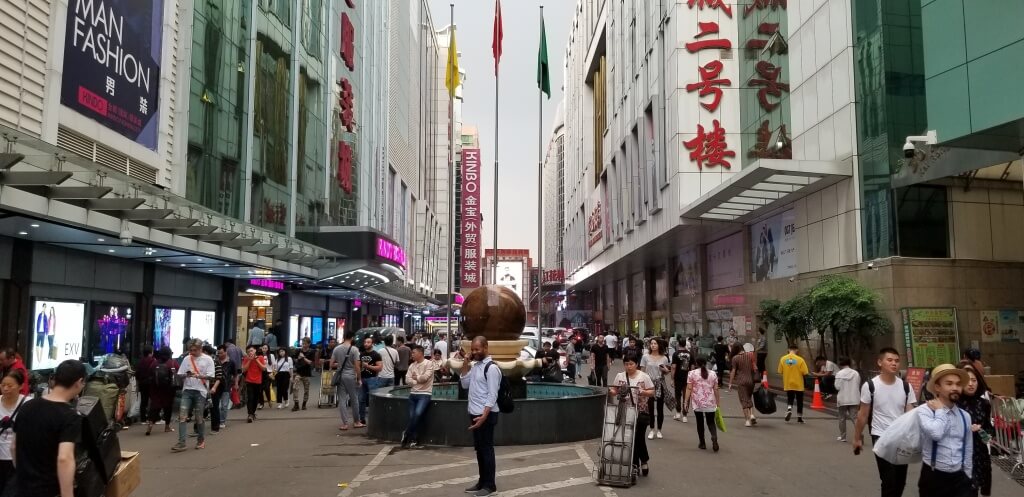
-
Каталог рынков Гуанчжоу. — список всех оптовых и розничных рынков Гуанчжоу.
-
Международный оптовый рынок обуви: на одной улице ZhanXi Lu, 26, метро: Guangzhou Railway Station (广州市站西路26) расположилось больше десятка торговых центров, специализирующихся на продаже обуви. Именно сюда приезжают все иностранцы, для оптовых и розничных закупок обуви.
-
Рынок сумок и товаров из кожи: Baiyun World Leather Center (白云皮具市场) — один из самых крупных рынков сумок во всем южном Китае. Здесь расположены десятки торговых центров, в которых можно найти сумки, рюкзаки, кошельки на любой вкус. Также здесь представлены копии различных брендов.
-
Оптовые рынки одежды: находятся вокруг железнодорожного вокзала Гуанчжоу; самый знаменитый из них — Торговый центр «шарик».
-
Рынок Часов: Zhangxi Watch Market (广州站西钟表城) предоставляет колоссальный ассортимент наручных часов (как оригиналов местных китайских марок, так и подделок).
-
Сигуаньская улица антиквариата (西关古玩城) — для всех любителей старины и китайской истории.
-
Нефритовая улица (玉器街) Здесь можно найти различные изделия из нефрита и других драгоценных камней.
-
Оптовый рынок игрушек и сувениров (玩具街) — торговая улица на которой расположены десятки торговых рынков, где можно найти различные товары от мягких игрушек и сувениров до квадокоптеров и гироскутеров. Находится в районе улицы Yidelu (一德路), на шестой линии метро, станция «Yide Lu»).
-
Улица свадебных платьев (婚纱专卖街) — оптово-розничный рынок свадебных товаров и платьев, находится в районе улицы Jiangnan dadao bei.
-
Рынок товаров широкого потребления (日用百货街) – на улице Гаоди (高第街). Здесь можно приобрести товары повседневного спроса.
-
Улица традиционных товаров (古玩字画街 / 文化商业街) – на улице Вэнде, Первая линия метро, станция «Peasant movement institute»). Отличное место, чтобы приобрести антикварные товары и традиционные сувениры китайских мастеров.
-
Рынок традиционных товаров Цинпин (清平市场) — рынок товаров традиционной китайской медицины и продуктов. Находится рядом со станцией метро Huangsha, к северу от острова Шамьень. Рынок изобилуют экзотическими и необычными товарами и продуктами питания: морские коньки и огурцы, травы и коренья, сушеные насекомые и многое другое. Несколько передних рядов отводится продавцам сушёных трав, используемых в традиционной медицине. Весь шарм рынка заключается в том, что современные новостройки в нём соседствуют со старыми узкими кантонскими улочками, торговля на которых велась на протяжении многих веков.
-
Рынок электронных товаров Dashatou (大沙头) — Находится на станции метро DongHu,здесь продаётся бытовая техника, спортивные товары, ткани, аксессуары для фотоаппаратов и электроника.
-
Рынок телефонов и компьютерной техники: (百脑汇电脑城) – Рынок электроники, компьютеров, телефонов и аксессуаров, находиться в районе Тяньхэ (метро 3, Ganding).
-
Рынок сувениров и игрушек: (万菱广场) – (станция метро Haizhu Square) оптовый рынок сувениров, игрушек, подарков, бижутерии и декора.
Торговые центры Гуанчжоу
Метро: Gong Yuan Qian, выходы C, D.
Это главная торговая улица в городе, большинство магазинов на которой работают с 9 утра до 10 вечера. Будьте внимательны: на ней часто встречаются продавцы, торгующие пиратскими дисками и поддельными товарами. Не соглашайтесь на предложение проследовать в тёмный переулок, чтобы посмотреть на товары. И не забудьте посетить центр Mayflower Plaza (五月花广场 wǔ-yuè-huā-guǎng-chǎng), расположенный по адресу: 5-ая улица Чжоншань, 68 (中山五路68号) в конце пешеходной улицы. Это популярное среди молодёжи место для проведения досуга.
Метро: станция Changshou lu, выходы D1, D2.
Данный торговый район примечателен традиционной кантонской архитектурой. Он особенно красив по ночам, когда включается освещение. Цены здесь заметно ниже, чем на улице пекинской улице, но для этого будьте готовы торговаться. Рекомендуем заглянуть в торговый центр Liwan Plaza (荔湾广场), находящийся по адресу: Dexing road 9 (德星路9号) на восточном конце улицы Шансядзиу. Здесь вы сможете приобрести изделия из хрусталя.
Метро: третья ветка метро, станция Shi Pai Qiao.
Современный торговый центр, построенный для состоятельных клиентов. На третьем этаже расположены кафе в западном стиле и бистро, популярные среди экспатов и местных . Книжный магазин «Фаньшу», находящийся на первом этаже, является одним из самых крупных в Китае.
Метро: станция «Martyr’s park»
Адрес: третья улица Чжоншань, 33 (中山三路33号)
Данный торговый центр крайне популярен среди молодёжи, а его дизайн выполнен в современном стиле. Прямо под ним находится станция метро, а в самом центре можно найти огромный фудкорт, где подаются блюда любой кухни: от сычуаньской острой пищи до японских суши.
Метро: Tiyu Xilu
Находится по адресу: улица Tianhe lu, 208 (天河路208号). Расположенный прямо над станцией метро Тию Силу торговый центр Tee Mall является одним из самых популярных в городе.
Лучшее место для шоппинга в Гуанчжоу
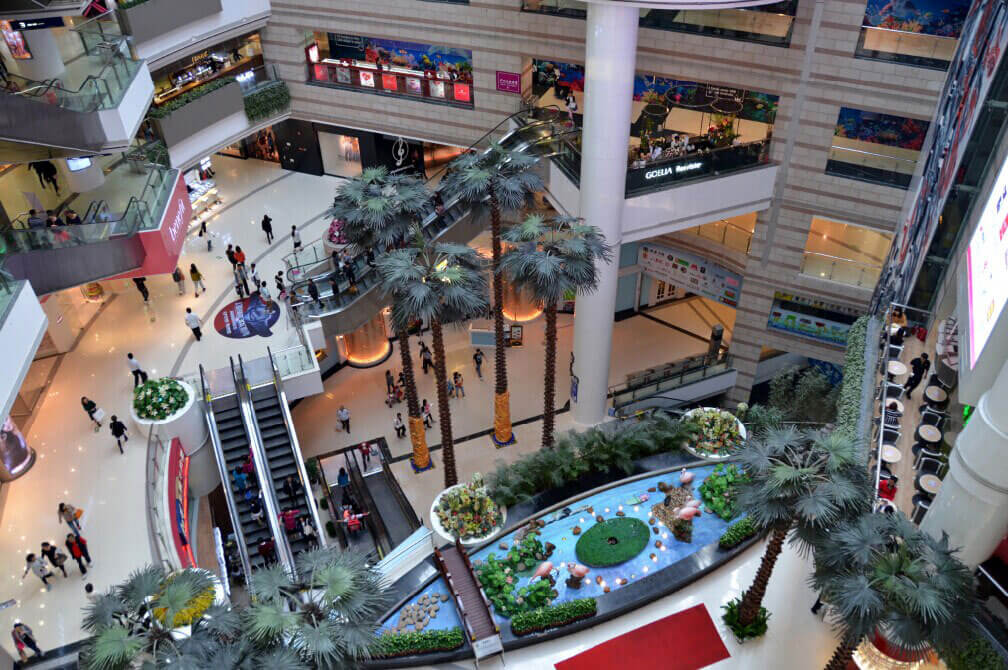
Адрес: 228, Tianhe Road, Tianhe District. Метро: Tianhe sport centre.
Это крупнейший торговый центр в Гуанчжоу, площадью более 300 тысяч кв.м ,расположенный в самом центре делового района Тяньхэ и является самым известным местом для шоппинга как местного населения так и туристов. Здесь можно найти как бутики одежды мировых и китайских брендов, электронику, косметику, парфюмерию и многое другое. Так-же в этом торговом центре расположено более 50 ресторанов как европейской, так и азиатской кухни (особенно можно отметить Latin restaurant со шведским столом), парк аттракционов с аквапарком, спа, фитнес клубы и многое другое.
Главные достопримечательности Гуанчжоу
- Остров Шамянь
- Телебашня Гуанчжоу
- Гора Байюнь
- Мавзолей императора Наньюэ
- Парк Юэсиу и статую пяти баранов
- Центральный сквер «Цветочный город»
- Храм шести баньяновых деревьев
- Мечеть Хуайшен
- Храм предков семьй Чэнь
- Опера Гуанчжоу
Основная статья: Все достопримечательности Гуанчжоу
Язык общения в Гуанчжоу
Официальным языком является мандаринский диалект китайского языка, на котором общаются практически все местные жители, не считая некоторых представителей старшего поколения. Коренные жители Гуанчжоу общаются на кантонском диалекте – чаще всего он встречается в старых районах и пригороде, нежели в центре города. Приезжие из других областей Китая общаются между собой на мандаринском диалекте.
В Гуанчжоу, процент англоговорящих, выше чем в остальном Китае (за исключением Пекина и Шанхая), однако они по-прежнему в меньшинстве, поэтому рекомендуется всегда носить визитную карточку своего отеля с адресом на иероглифах. Не ждите, что водители будут общаться с вами на английском, некоторые из них с трудом говорят даже на китайском. Для того, чтобы иметь возможность спрашивать дорогу у местных жителей, советуем записать название улиц и основных достопримечательностей на китайском языке (об этом можно попросить сотрудников отеля). Стоит отметить, что молодёжь в основном имеет базовые знания английского, а работники отелей, баров, ресторанов и других заведений, часто посещаемых туристами, как правило, говорят на вполне приемлемом уровне английского. Это касается в том числе и сотрудников Starbucks, Макдональдс, KFC и других сетевых ресторанов. Ученики старших классов и студенты по большей части понимают английскую речь, но отвечают с трудом. Если вы встретите на улице китайца, спокойно общающегося на английском языке, то скорее всего перед вами либо сотрудник иностранной компании, либо образованный студент, или человек, обучавшийся за границей.
Несмотря на то, что большинство граждан не владеет английским языком, надписи на дорожных знаках и вывесках выполнены на двух языках (китайский и английский), хотя в некоторых случаях английская версия явно составлялась при помощи онлайн-переводчиков.
Полезная информация по Гуанчжоу
Генеральное Консульство России в Гуанчжоу — General Consulate of the Russian Federation in Guangzhou
Время работы: 9:00 — 12:30, понедельник — пятница.
Контакты: +86 (20) 8518-5001, 8518-5002, 8518-5003 / Телефон для
экстренных
случаев: 13825051775.
Адрес Консульства в Гуанчжоу на английском: Guangzhou, Tianhe District, Zhujiang New Town, Linjiang dadao, 3, 26 Floor, Room 26A (Development centre)
Адрес Консульства в Гуанчжоу на китайском: 广州市天河区临江大道3号发展中心大厦26层A单 (俄罗斯总领事馆)
Если с вами случилась экстренная ситуация, вас задержала полиция, потеряли паспорт — советуем незамедлительно обратится в консульство.
Города рядом с Гуанчжоу
-
Фошань (佛山) — «Город Мебели», именно сюда ездят в мебельные туры, находится в часе езды от Гуанчжоу. Также знаменит своим буддистским храмом Zumiao (祖庙). Город является родиной легендарного мастера восточных единоборств Хуан Фэйхуна и Брюса Ли. Чтобы добраться до этого города, необходимо пересесть на линию Гуанфо, со станции Xilang, расположенной на первой линии метро Гуанчжоу.
-
Кайпин (开平) – город, популяция которого начала активно расти в начале 20 века. С автовокзала ФанЦун (芳村汽车站) регулярно отправляются рейсы Кайпин. Дорога занимает 2 часа. Стоимость билета: около ¥70.
-
Гонконг (香港) находится в 1,5 часах езды на поезде от Гуанчжоу. Цена билета: 80-200CNY. Обязательно иметь в паспорте визу на обратный въезд в Китай.
-
Дунгуань (东莞) и Хумен (虎门) знаменит своими достопримечательностями эпохи Опиумных войн (虎门销烟). Он находится неподалёку от района Наньша. Большинство поездов, направляющихся в Шэньчжэнь или Гонконг, останавливаются в Дунгуане.
-
Шэньчжэнь (深圳) находится на границе с Гонконгом. Это одна из первых специальных экономических зон в Китае. Город знаменит своими тематическими парками, в числе которых «Окна мира», «Китайские народные деревни» и «Сказочный Китай». Добраться до него можно как на автобусе, так и на поезде. Стоимость билетов составляет ¥80-100.
- Макао (澳门) и Чжухай (珠海) – это ещё одна специальная экономическая зона, на юге граничащая с Макао. Практически с любого автовокзала Гуанчжоу регулярно отправляются рейсы в Чжухай. Также можно сесть на высокоскоростной поезд на Южном железнодорожном вокзале (Вторая линия метро, станция «South Railway Station»). Поездка займёт около 45 минут и обойдётся в 70 юаней.
- Юнфу — (Yunfu,云浮) — небольшой город который находится к западу от Гуанчжоу. Город знаменит тем, что здесь добываются и продаются изделия из натурального камня и мрамора. Именно поэтому, город получил неофициальное второе название: «Город камня», здесь располагаются десятки крупнейших рынков в Китае по продаже камня. Расстояние от Гуанчжоу — 150км, можно добраться только на автобусе, стоимость билетов — 70юаней.
Безопасность в Гуанчжоу: чего стоит опасаться.
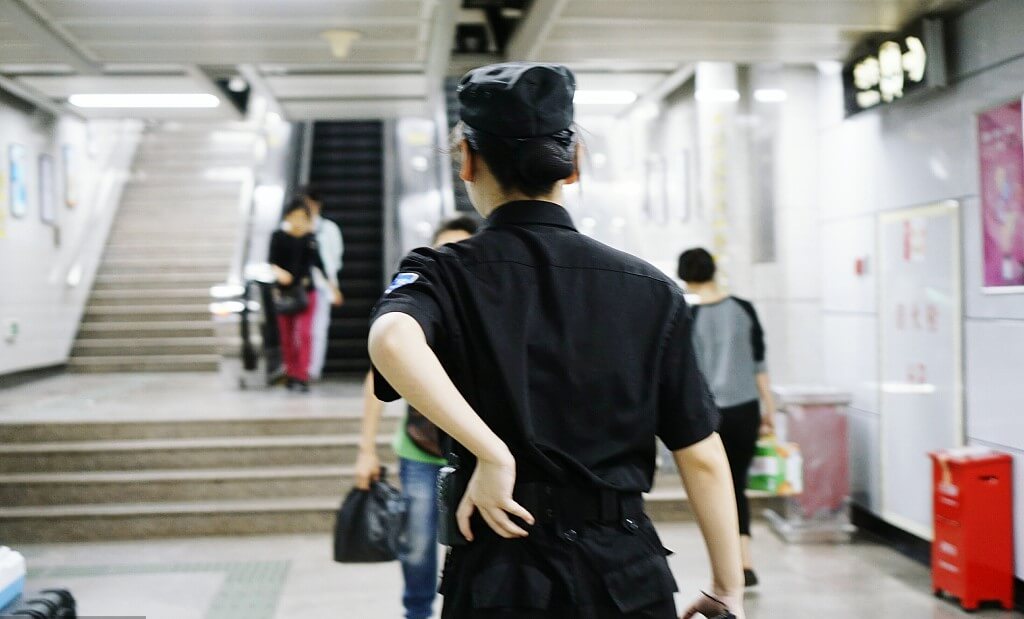
Если вы посещаете город впервые, то будьте внимательны: некоторые таксисты обманывают клиентов, доставляя их в удалённые части города и требуя за это повышенную оплату.
Поскольку это одна из самых богатых китайских провинций, она привлекает огромное количество рабочих из других провинций и стран. В местной полиции служат сотрудники, владеющие арабским и английским языками, привлечённые для борьбы с набирающей обороты торговлей наркотиками. Иностранцам, уличённым в хранении, употреблении, продаже наркотиков, грозит серьёзное наказание, вплоть до смертной казни.
Транспортные условия в Гуанчжоу значительно улучшились в последние годы после принятия новых законов. Тем не менее, как и в любой другой части Китая, машины редко останавливаются перед пешеходами – зебры нанесены на дороги исключительно для вида — будьте осторожны переходя дорогу.
Советуем всегда носить с собой паспорт, в последнее время участились проверки документов у иностранцев, особенно в питейных заведениях и ночных клубах. Если вы не хотите носить паспорт, сделайте ксерокопию первой страницы и визы и держите всегда при себе.
Номера экстренного вызова: Полиция — 110; пожарная служба — 119; скорая помощь — 120; горячая линия по ДТП — 122.











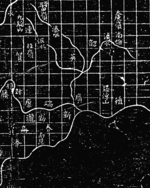


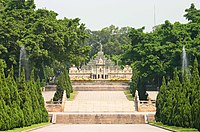
![Nieuhof's imaginative 1665 map of "Kanton",[121] made from secondhand accounts when Europeans were still forbidden from entering the walled city](https://upload.wikimedia.org/wikipedia/commons/thumb/6/67/Nieuhof-Ambassade-vers-la-Chine-1665_0744-2.tif/lossy-page1-281px-Nieuhof-Ambassade-vers-la-Chine-1665_0744-2.tif.jpg)
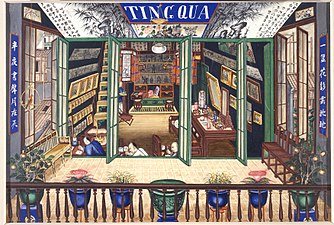
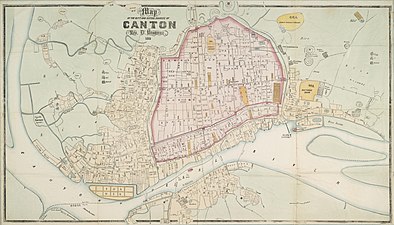
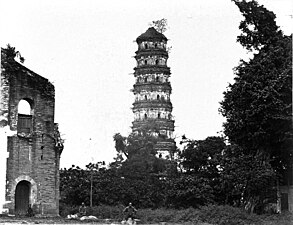
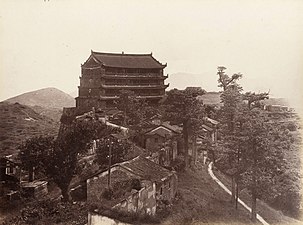

![The US Navy's Dept of Navigation's 1920 map of "Canton"[122]](https://upload.wikimedia.org/wikipedia/commons/thumb/7/76/Canton1920_d006_map_of_of_the_city.jpg/402px-Canton1920_d006_map_of_of_the_city.jpg)
